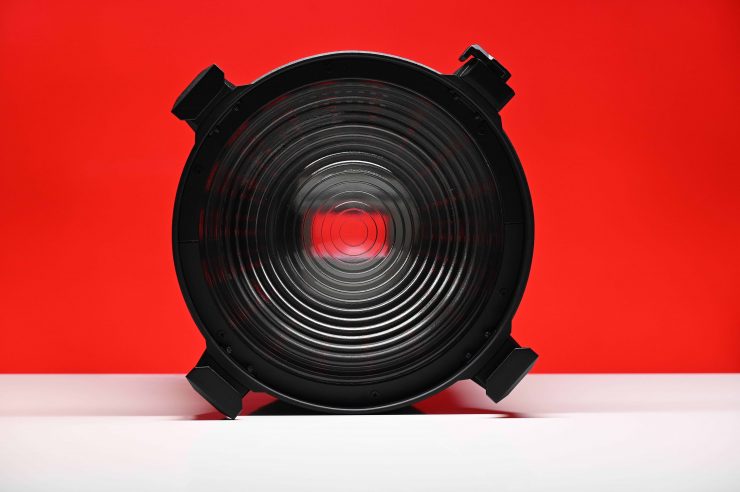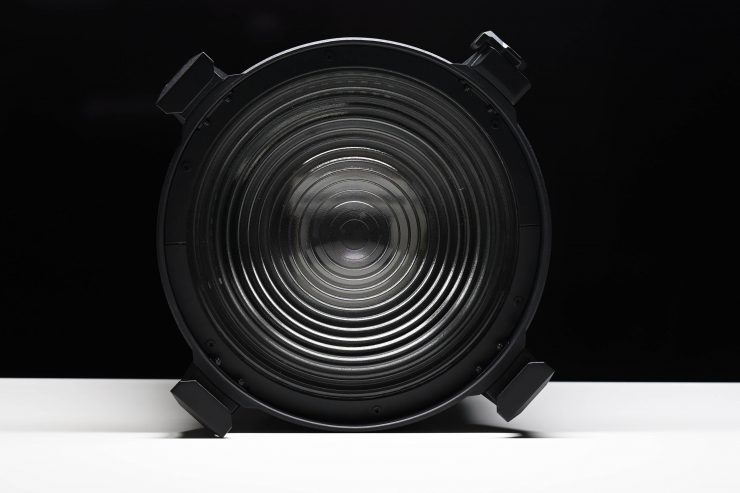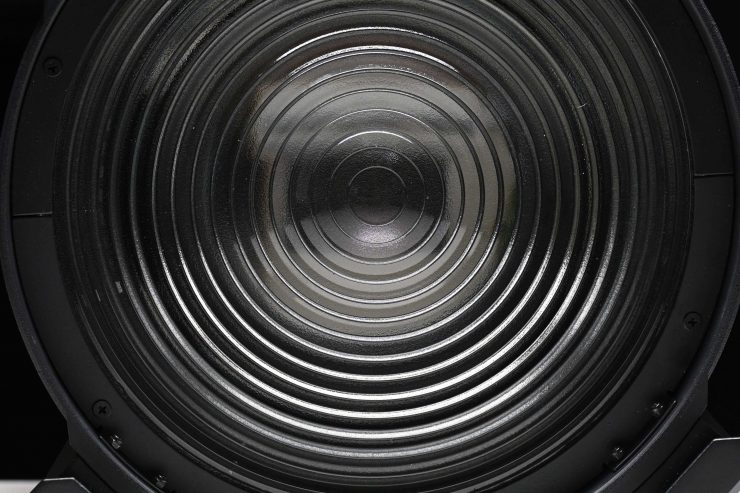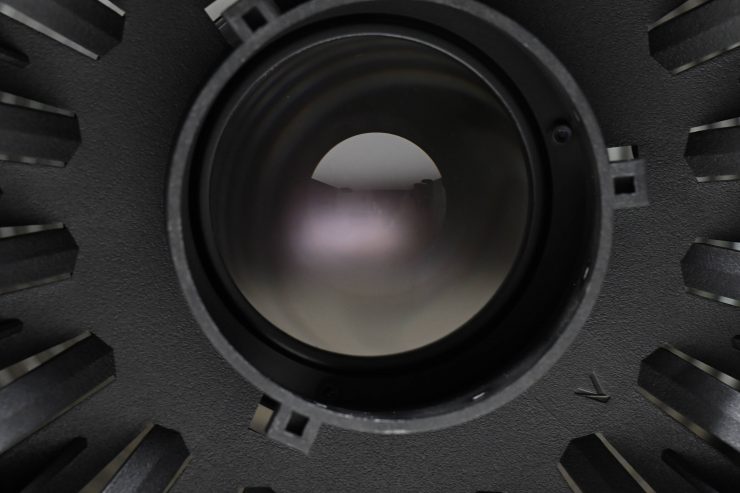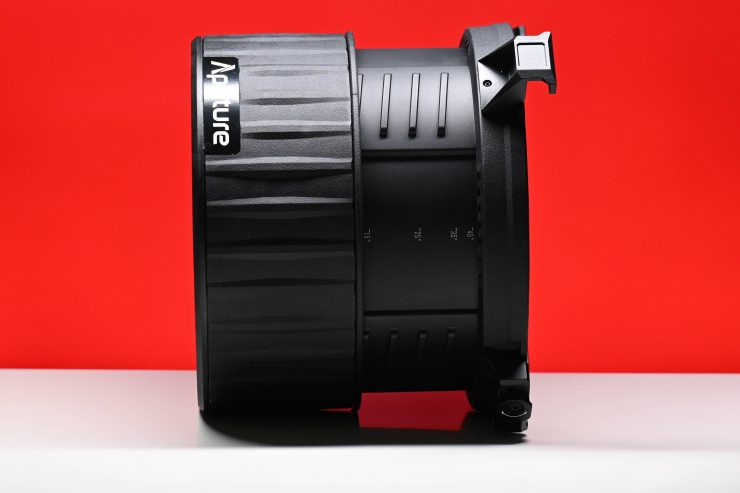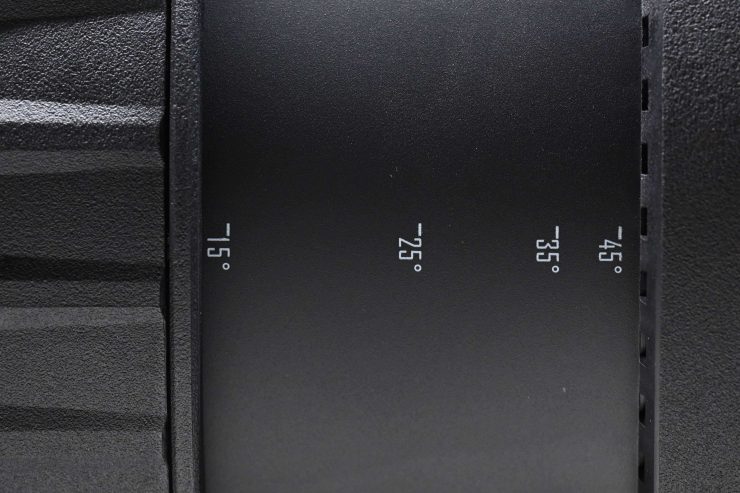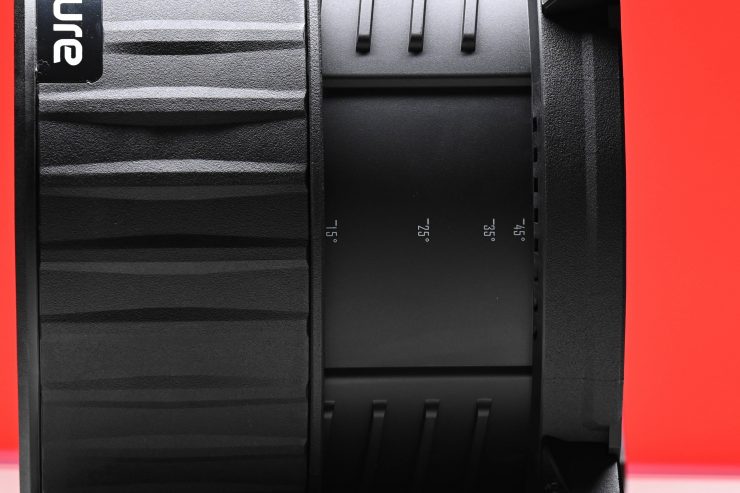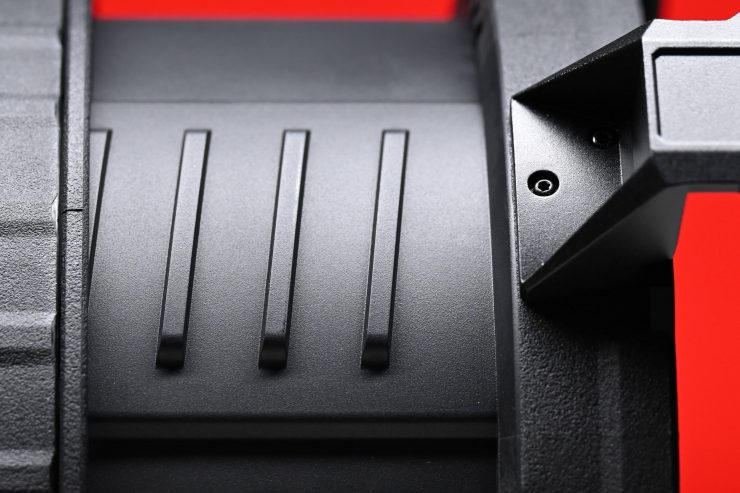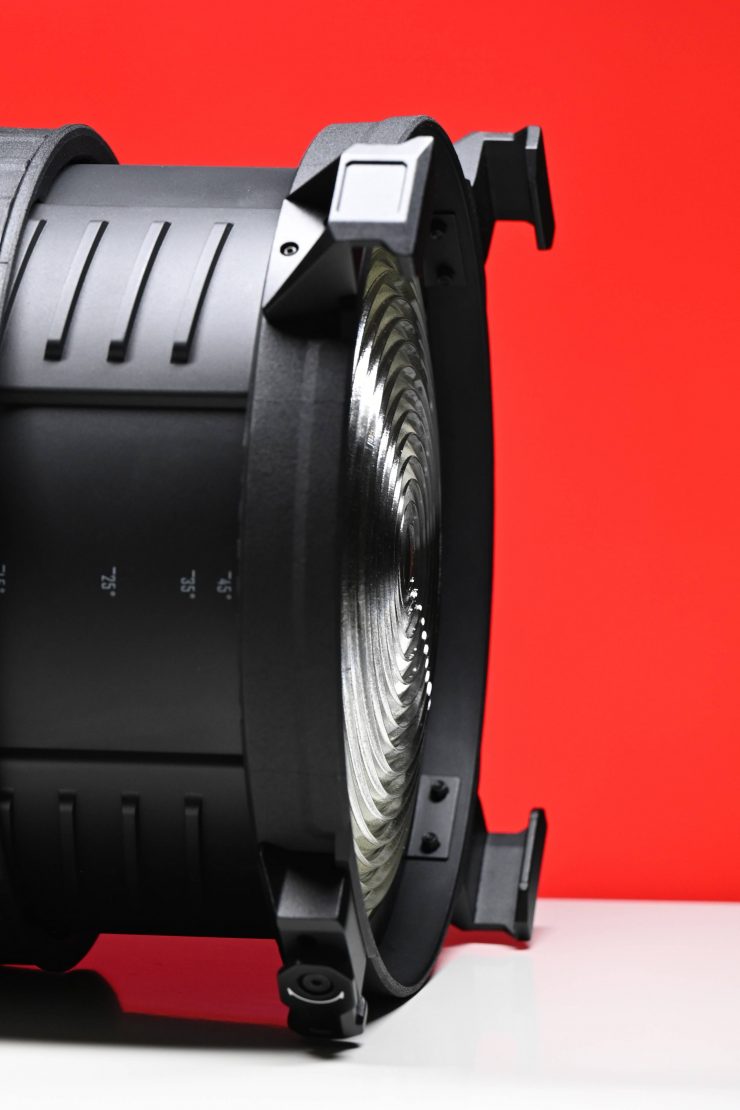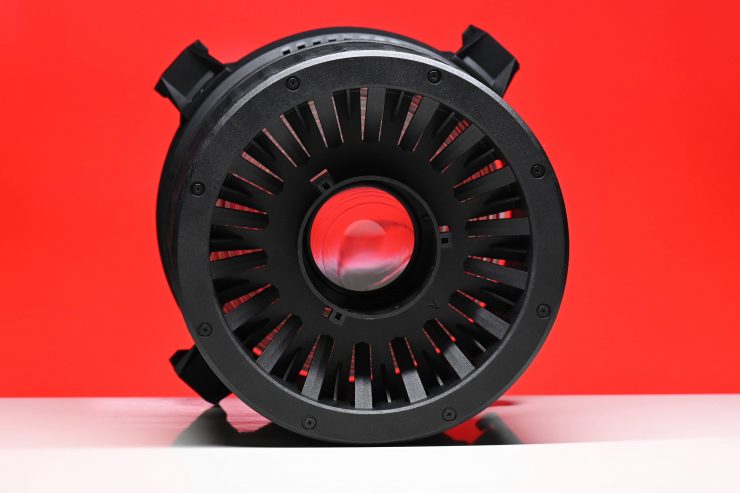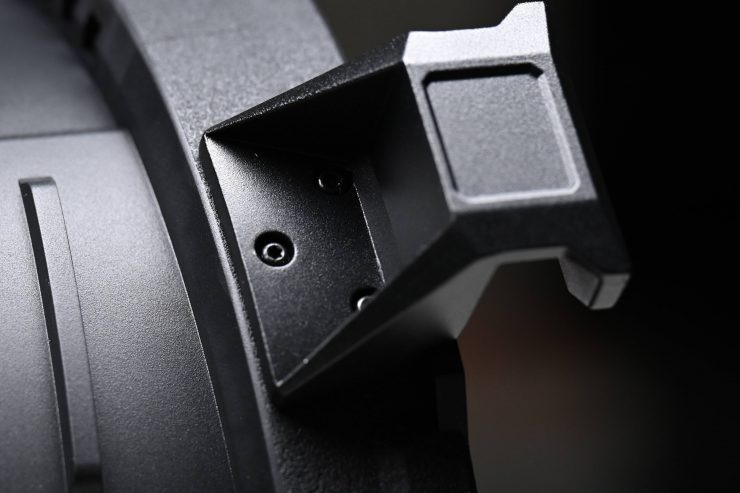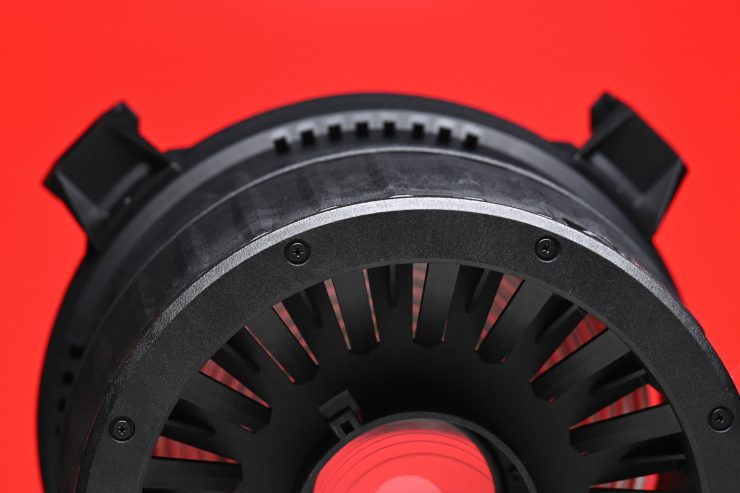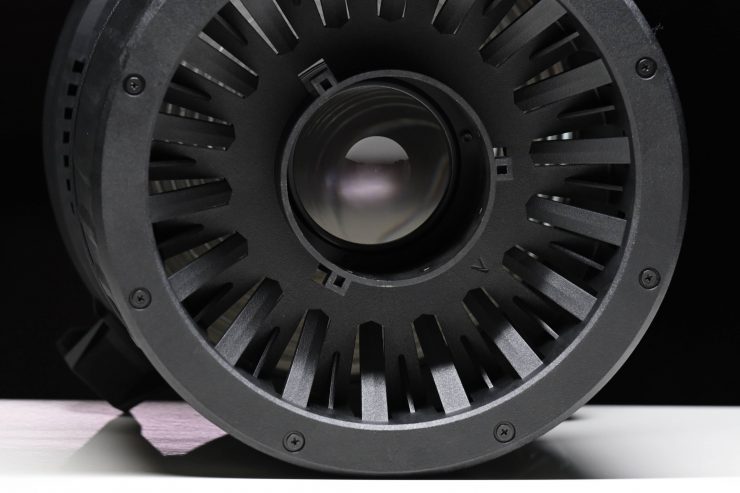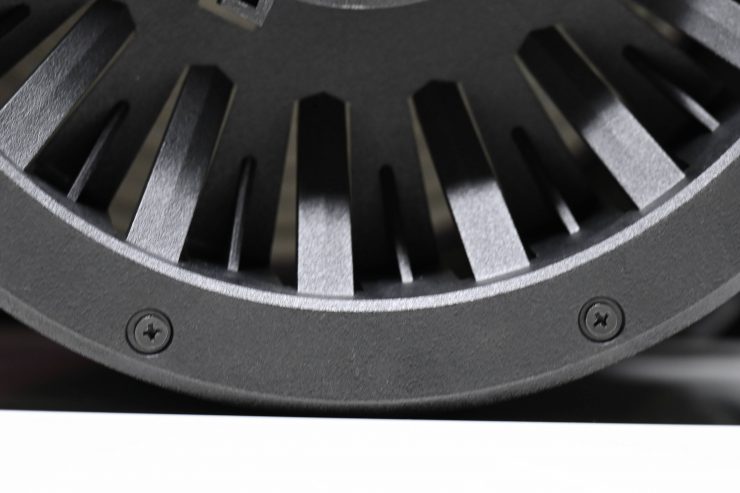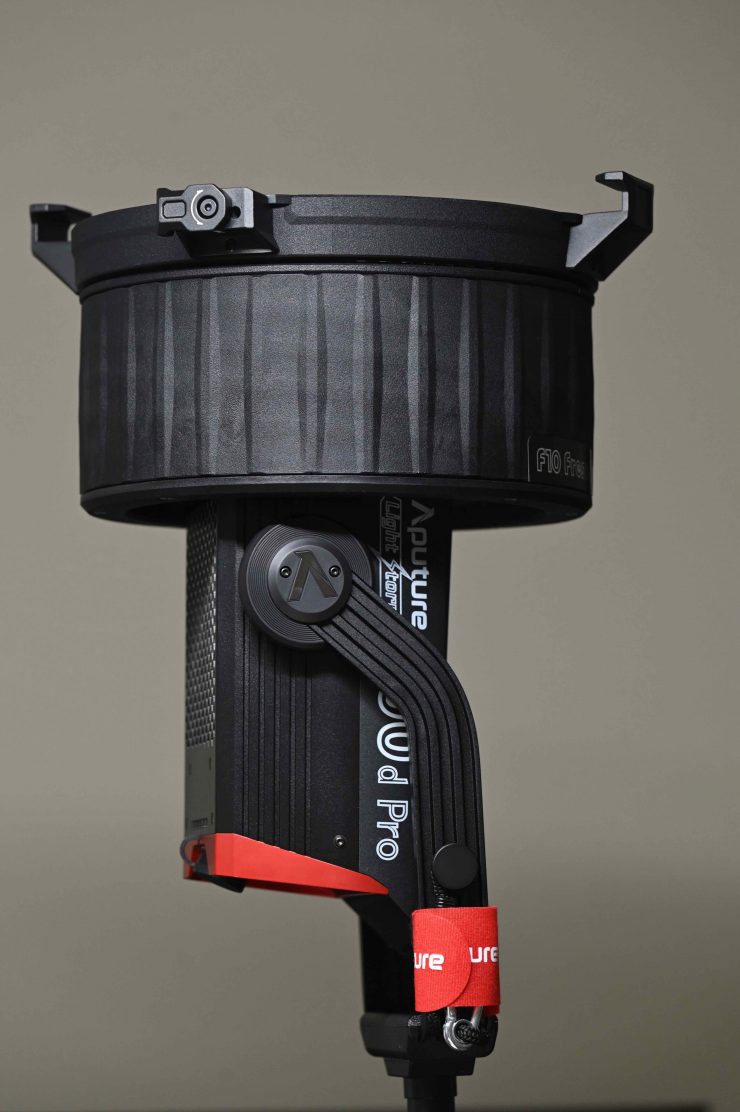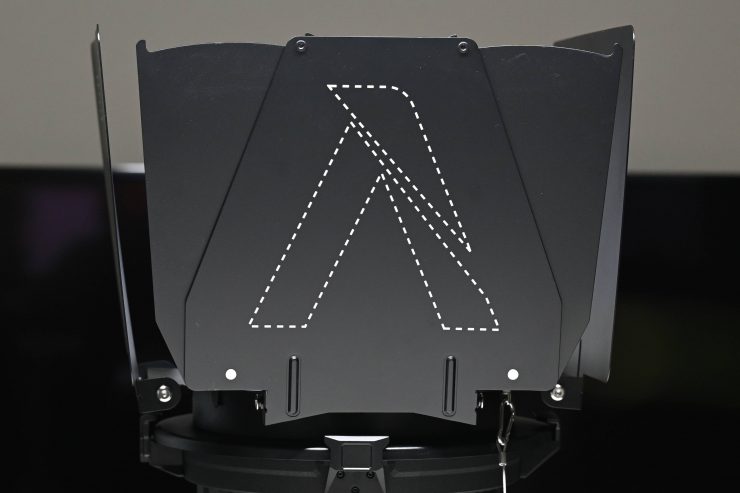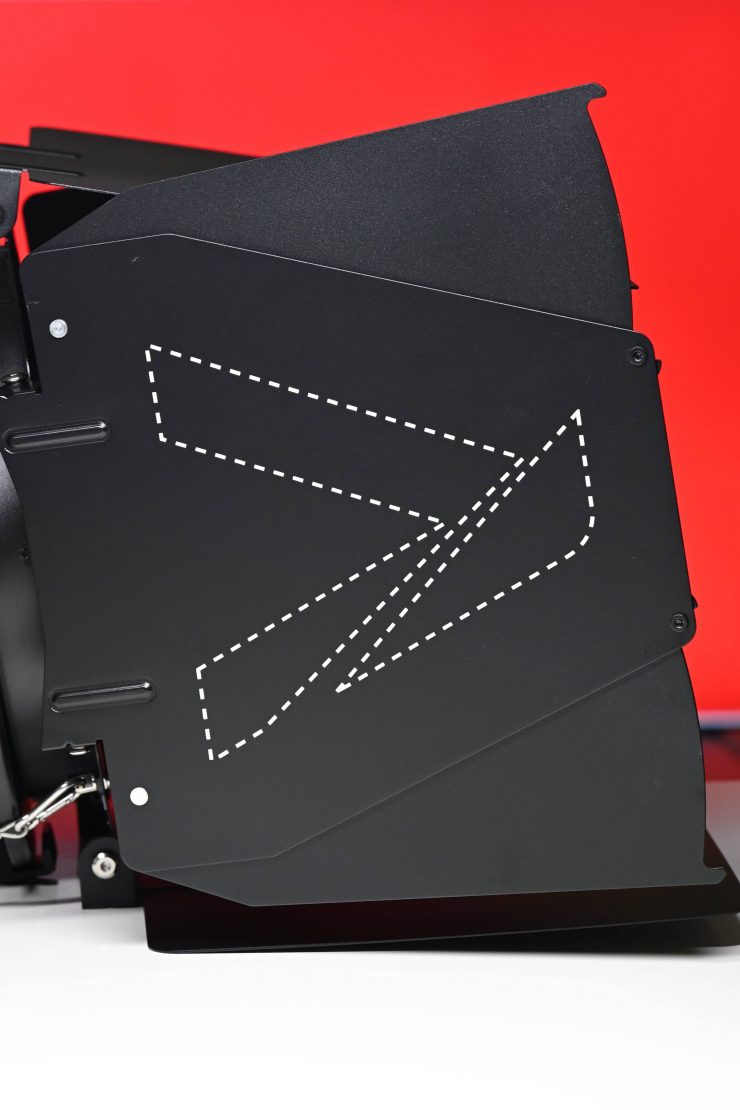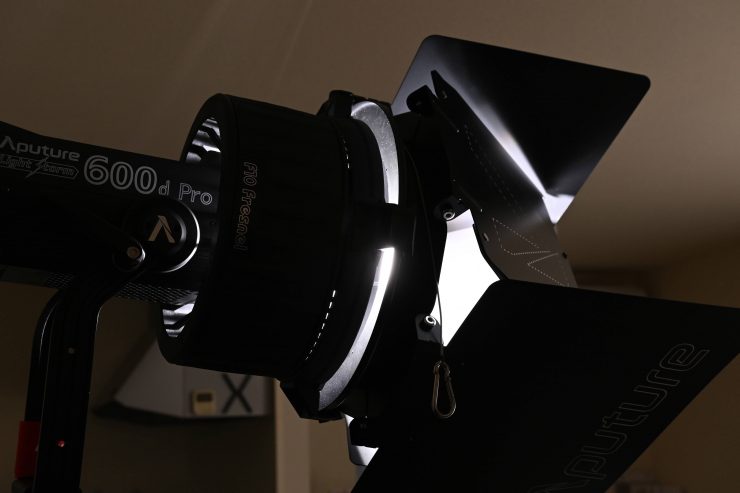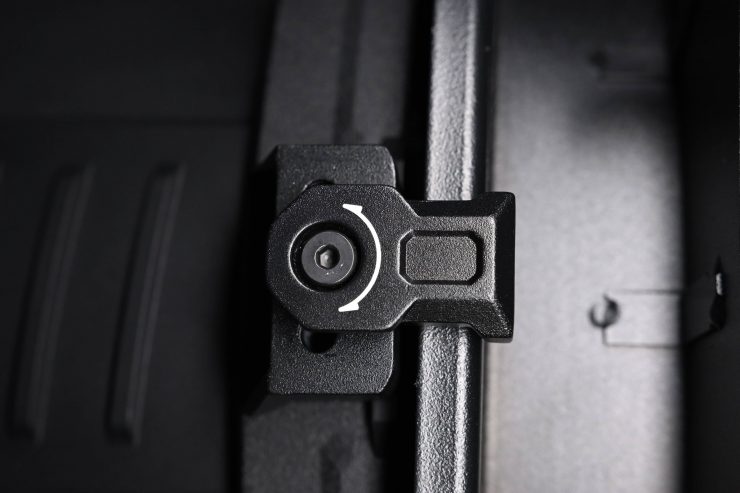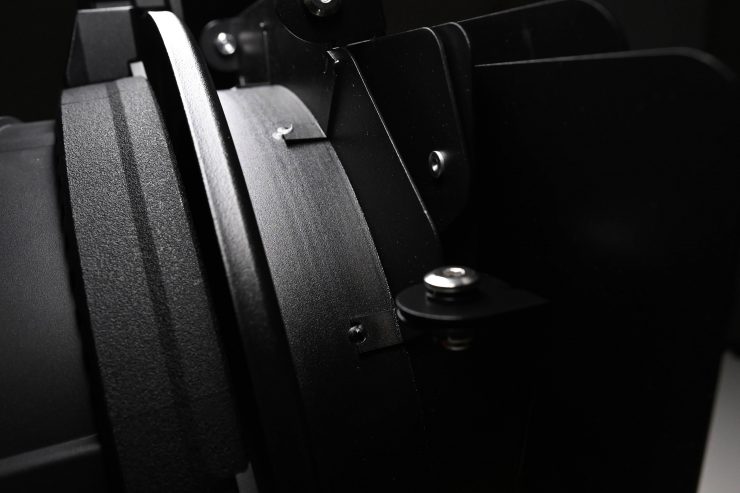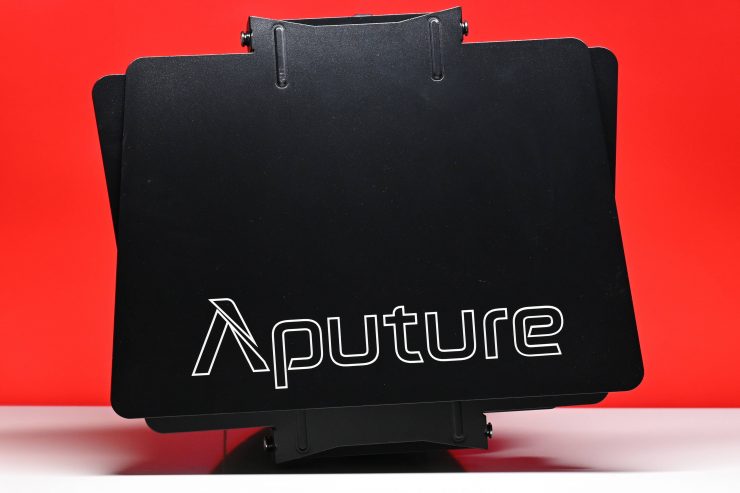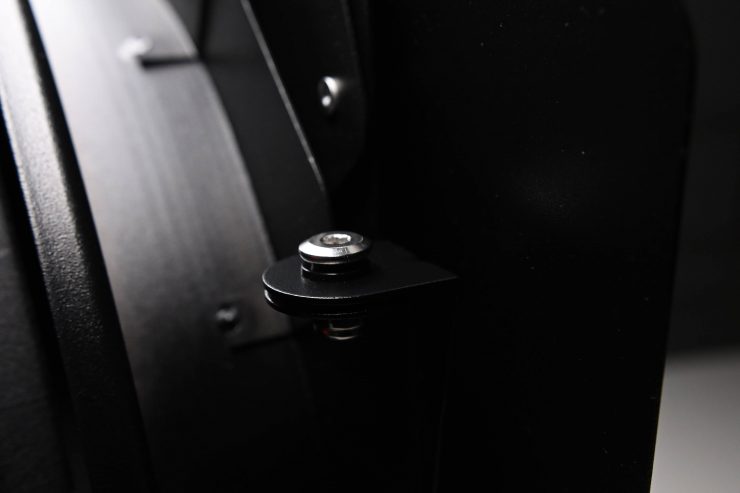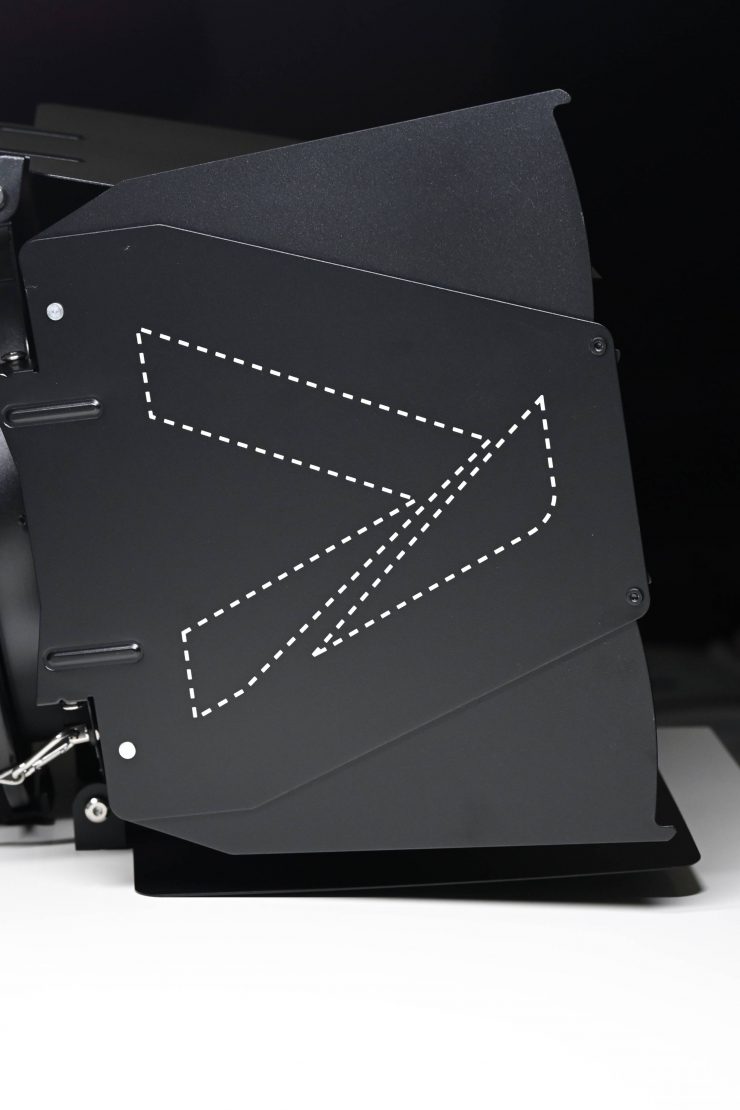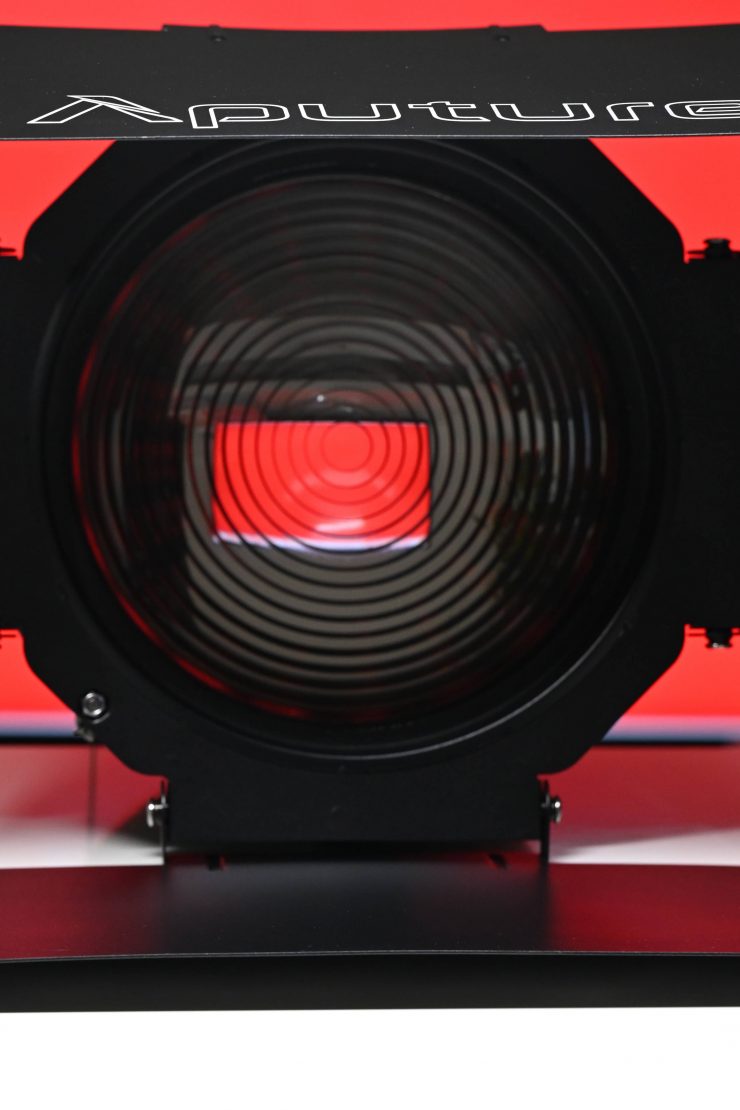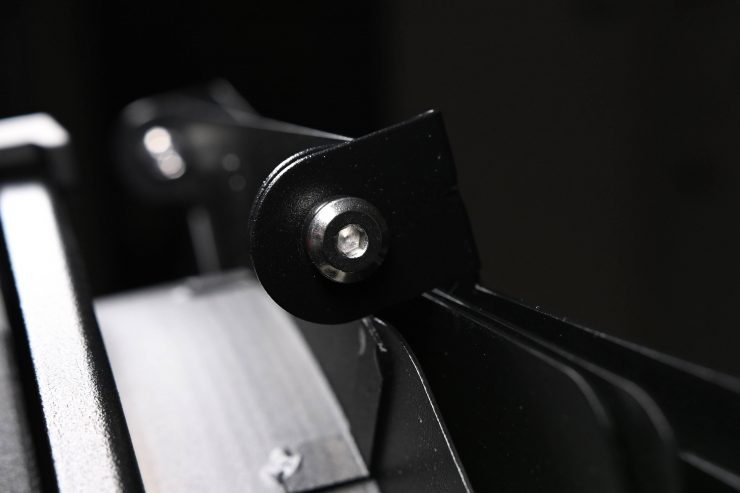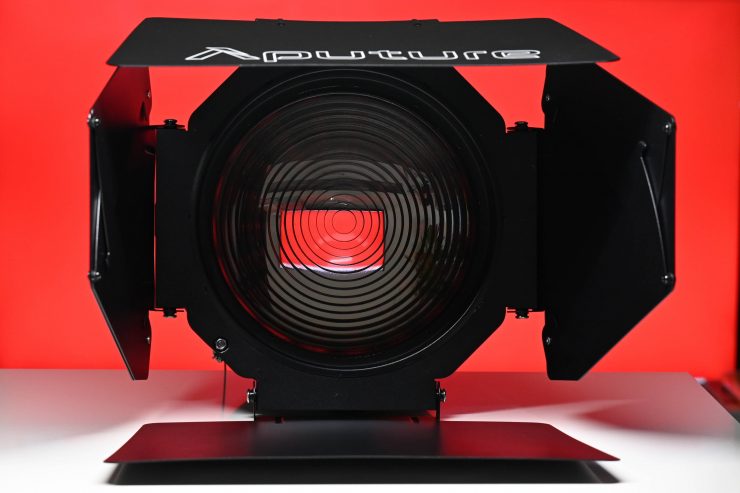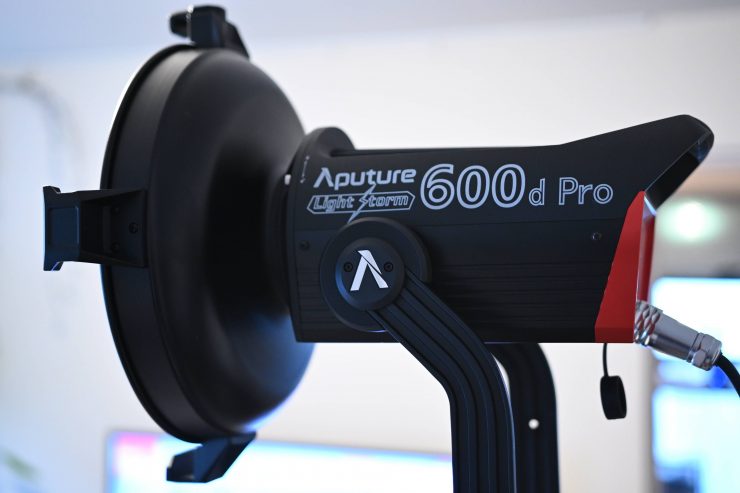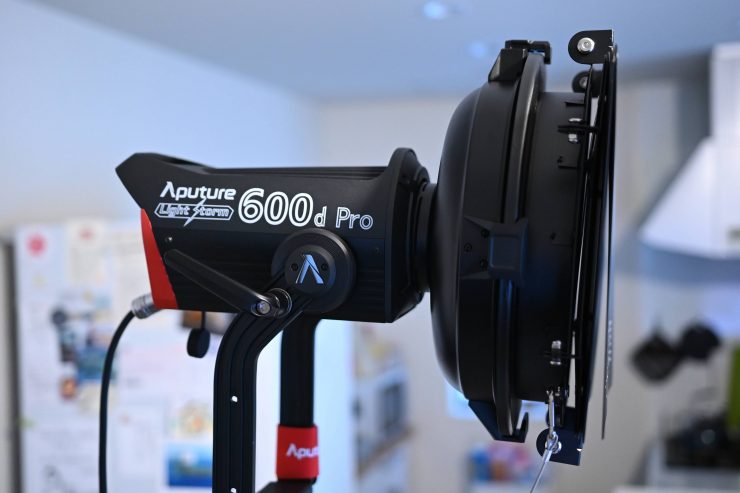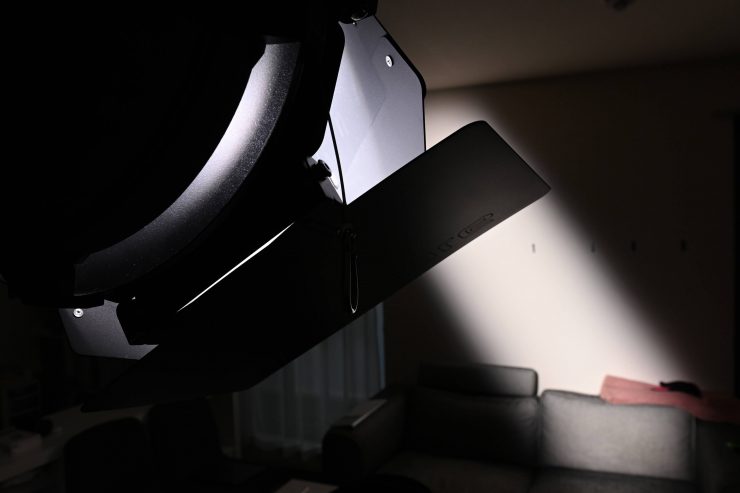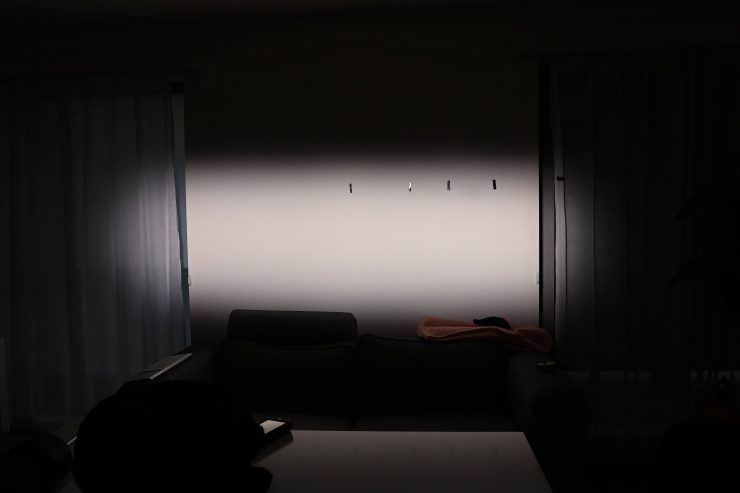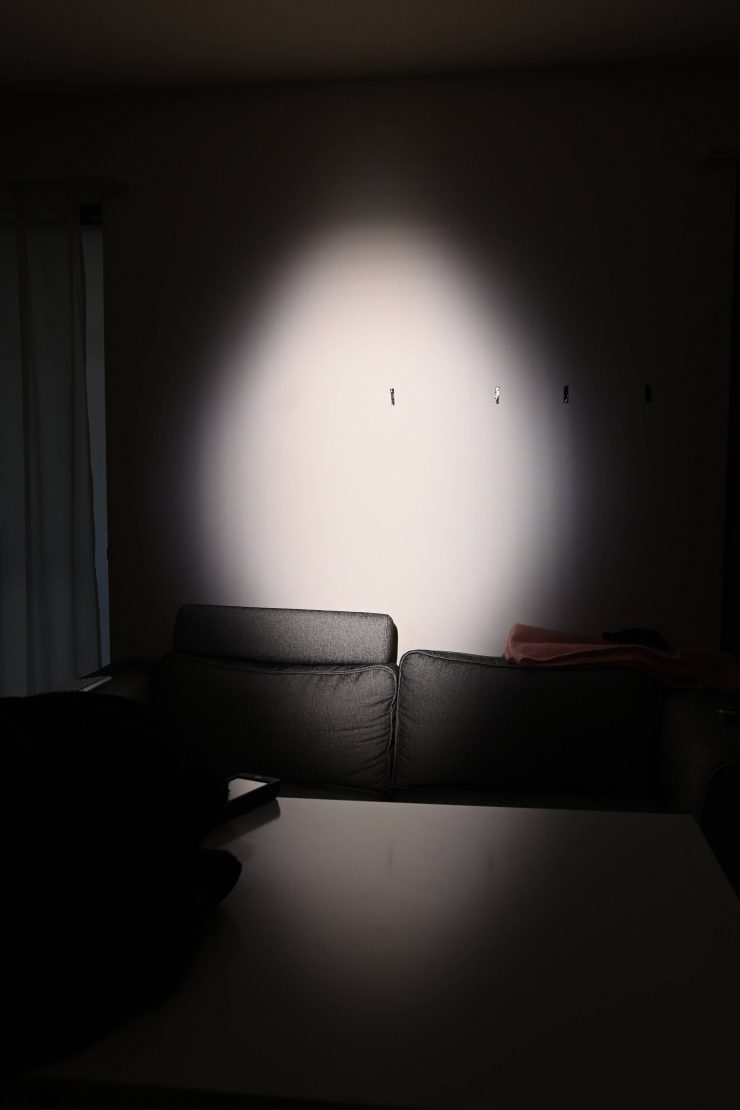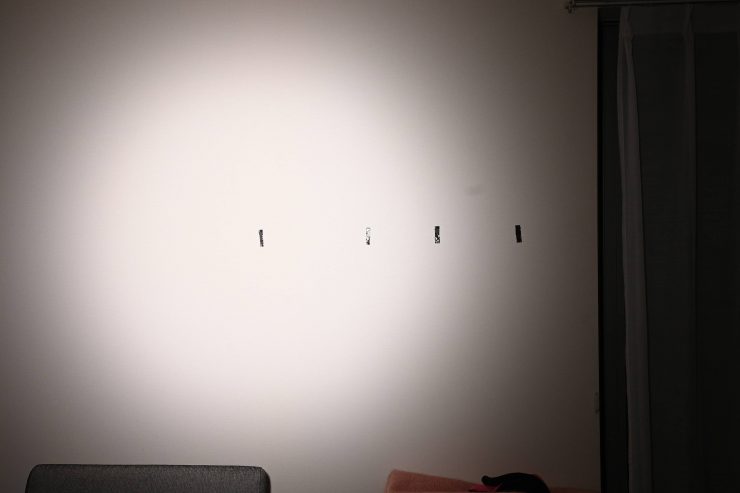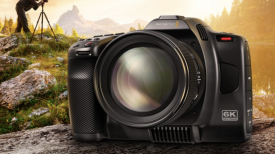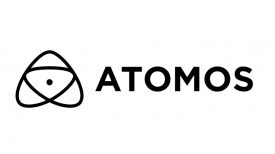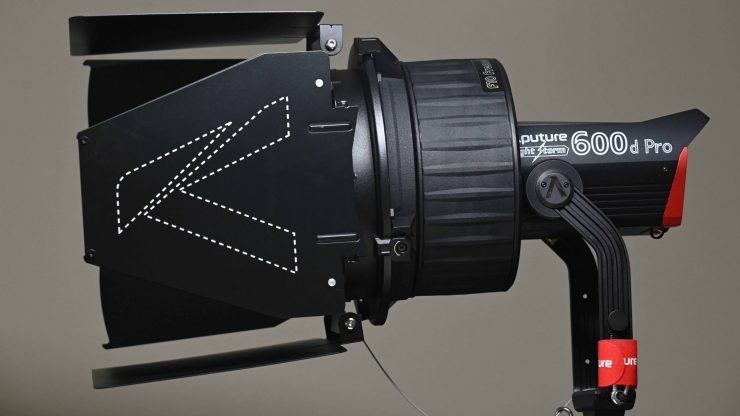
The Aputure F10 Fresnel Attachment is the latest accessory for the LS 600d Pro. It allows you to turn the COB point source fixture into a Fresnel easily and most importantly, without emptying your wallet.
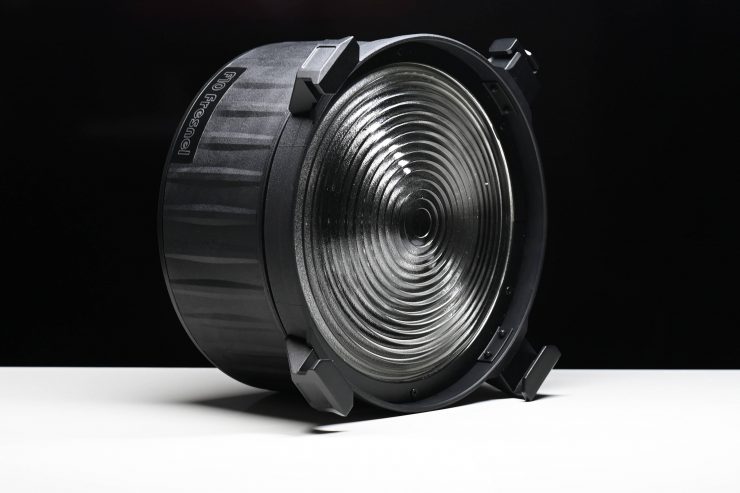
Key features
- 15 to 45° Variable Beam Angle
- Vented Design Disperses Heat
- Dual Lens Optical Design
- Up to 200,000 lux @ 3.28′ with the Aputure LS 600d
- 10″ Glass Fresnel lens
- Compatible with F10 Barn Doors
- Seamless focus adjustment
- Minimizes light leaks
Size & weight
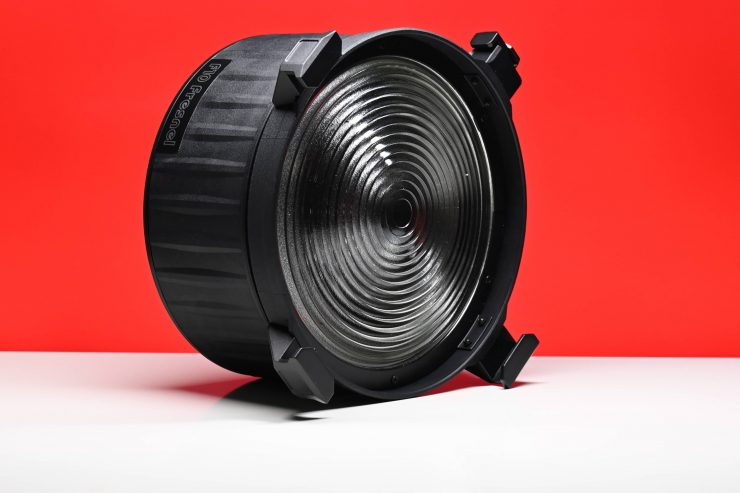
I’m not going to sugarcoat it, the F10 Fresnel is large and heavy. I independently weighed it at 3.9kg (8.59 lb). Just as a reference, the actual 600d Pro light head weighs in at 4.64kg / 10.23 lb (Including Yoke).
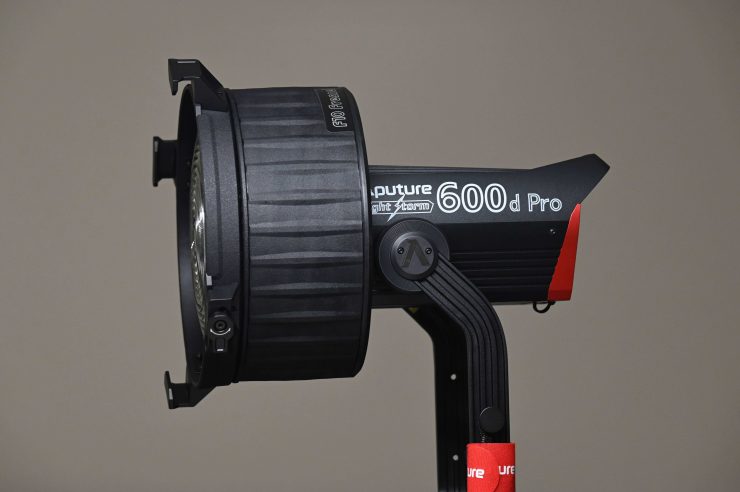
Now, there is a very legitimate reason why the F10 Fresnel is so big. When building a Fresnel for a COB LED fixture you need to match the size of that COB element to the size of the Fresnel. Often I have seen small-sized Fresnel attachments for these COB LED lights that are too small and they don’t work well. If the Fresnel attachment is too small in relation to the COB, the light getting to the Fresnel won’t be optimized. In this case, size does matter!
Fresnel lens
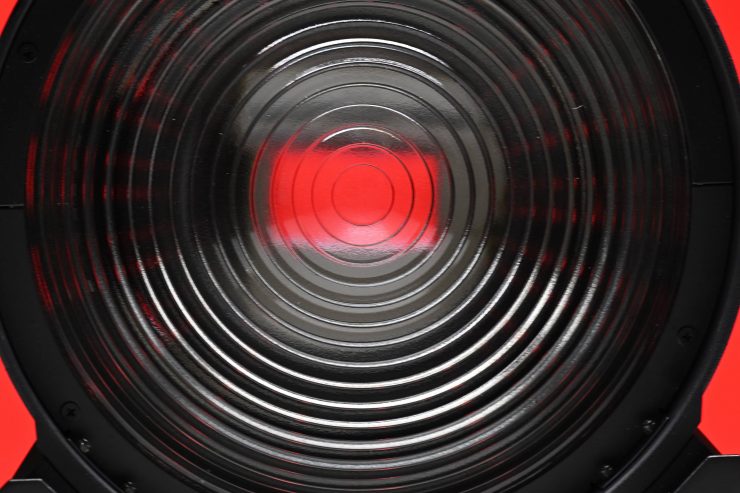
The F10 uses a 10″ / 25.4 cm glass Fresnel. This is an industry-standard size for Fresnel glass. This is nice to see, as quite a lot of affordable large-sized LED Fresnel fixtures use acrylic and are not an industry size.
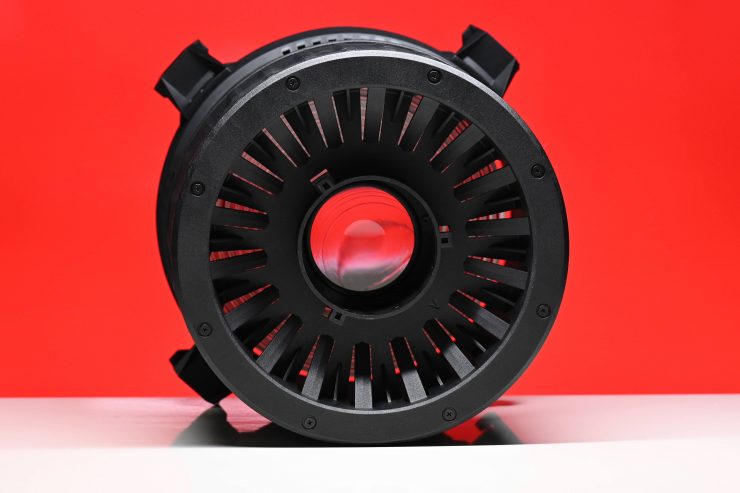
What is also different compared to a lot of other LED fresnels is that the F10 utilizes another piece of glass at the back that throws the light at the front Fresnel element. Why is this important to know? Well, this design helps to maximize the amount of output you can get out of the 600d Pro.
Another benefit to having a 10″ glass Fresnel is that wire kit inserts that worked on HMIs and older Fresnels will work with the F10. The only slight caveat is that it will only fit one.
15° to 45° Variable Beam Angle
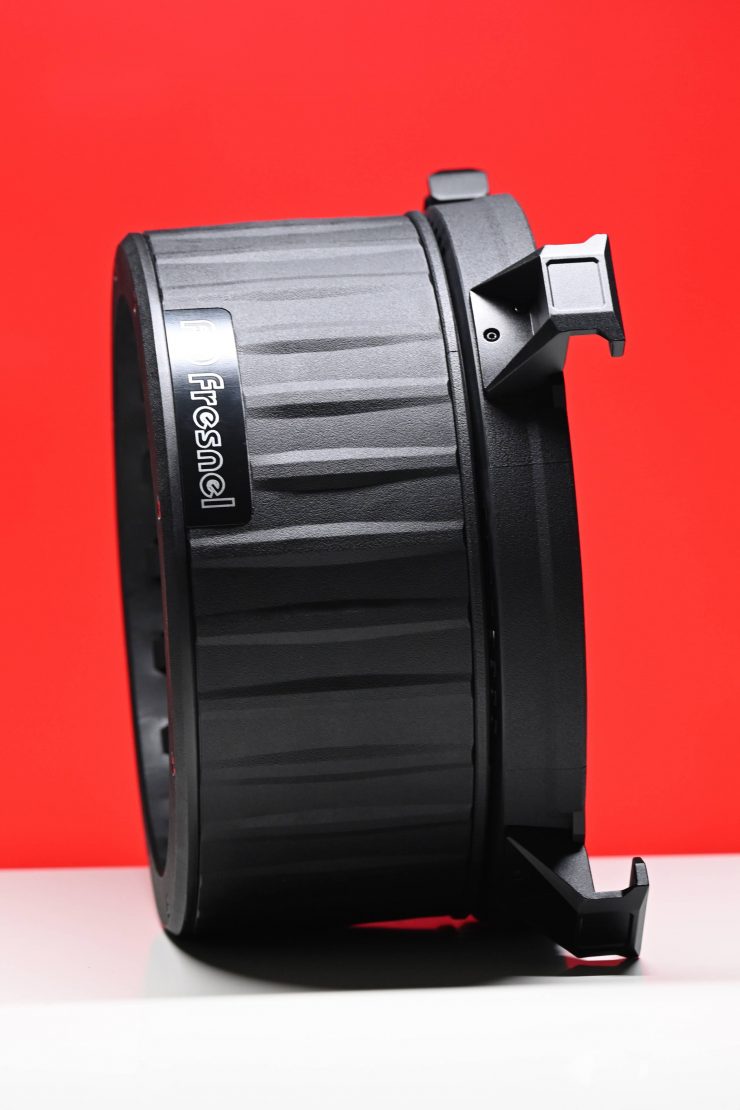
The F10 Fresnel allows you to adjust the beam angle from 15° to 45°. This is not a massive amount, however, it should suit most people’s needs.
To adjust the beam angle you simply just rotate the outer housing of the F10. This is fairly easy to do.
As a reference, most high powered HMI fixtures will flood out to around 65°.
Build Quality
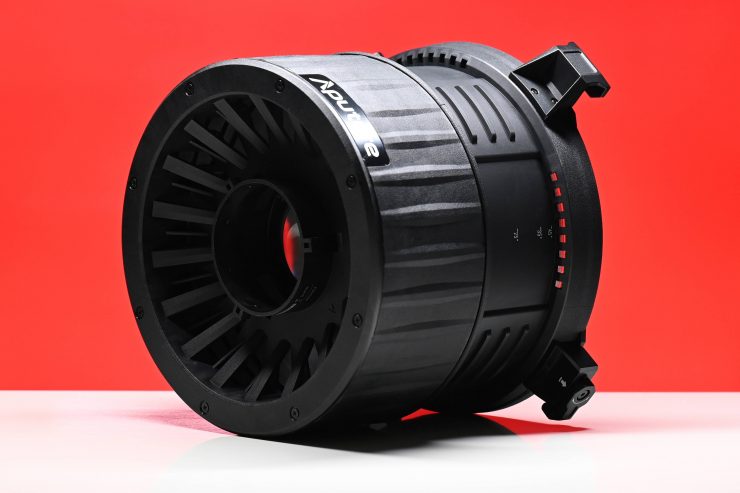
The F10 Fresnel is well made and it feels nice and sturdy. There was nothing in regards to build quality that concerned me.
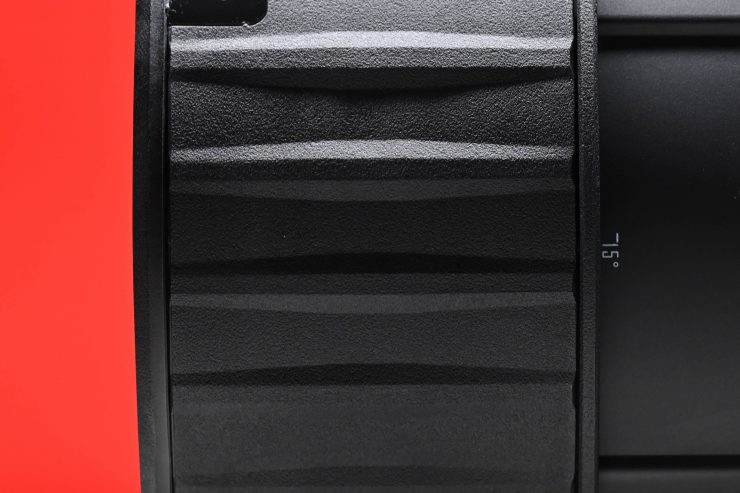
The adjustment ring for the Fresnel operation isn’t made out of metal, instead, it uses a composite type material. The nice aspect about this is that this type of material is that certainly helps to dissipate heat.
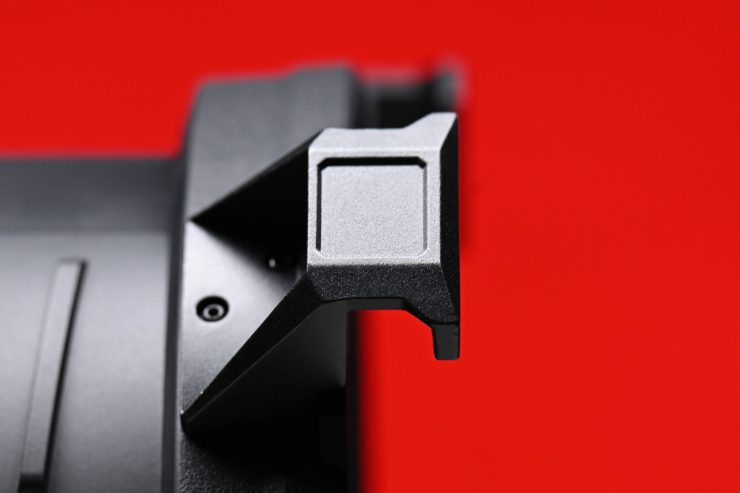
The barn door holders use three screws and there are lots of other screws utilized to hold the Fresnel together. I was impressed with the overall build quality.
How does it attach?
Like all of the other accessories, the F10 Fresnel attaches to the front of the 600d Pro via the Bowens mount.
It is a little tricky to attach but that is mainly due to the M10’s weight and physical size.
Range of motion when using the M10
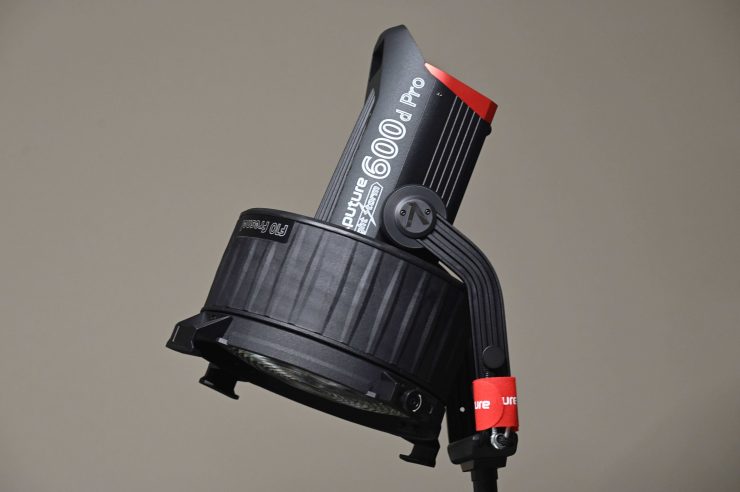
Even with the large F10 Fresnel attached to the 600d Pro, you can still get a good range of motion for adjusting the position of the light.
If you do put the optional barndoors on, then the range when angling the light down will be a little less.
Included Case
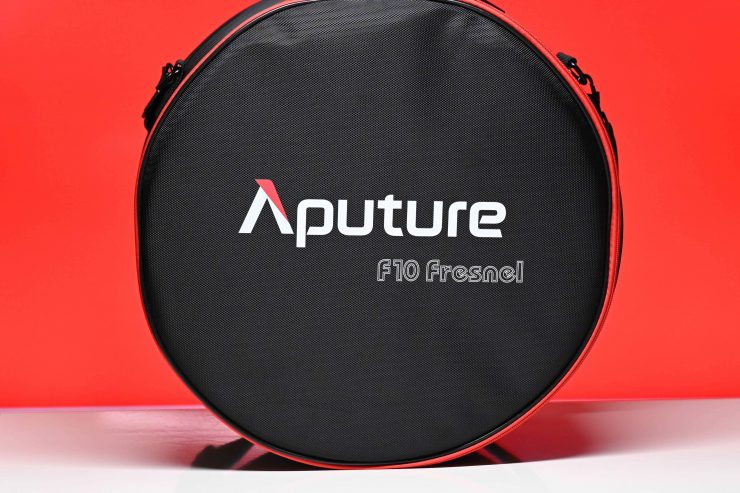
The F10 does come in its own carrying case, which looks like something you would put a snare drum in. The bag is ok, but in my opinion, it doesn’t reflect the quality of what is inside it.
If you are going to make a robust product that could be carried in rental houses you need to put it in an equally robust case. The case that comes with the F10 just feels a little cheap. Look, there’s nothing that wrong with it, but it could be a lot better.
Optional Barndoors
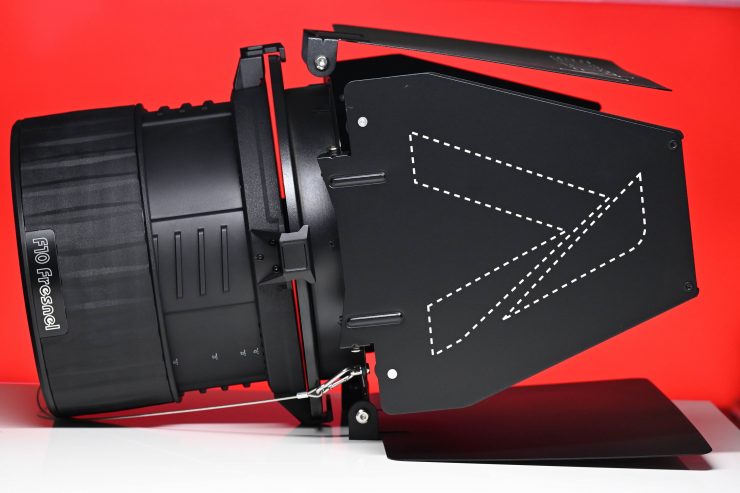
Aputure also makes optional 10” Metal Barndoors for the F10 Fresnel.
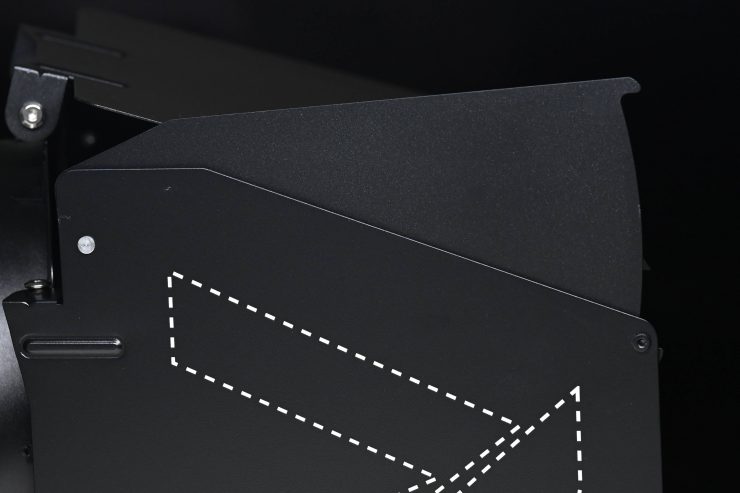
These barndoors have 8-leaf adjustability which is important when trying to cut light from large light sources.
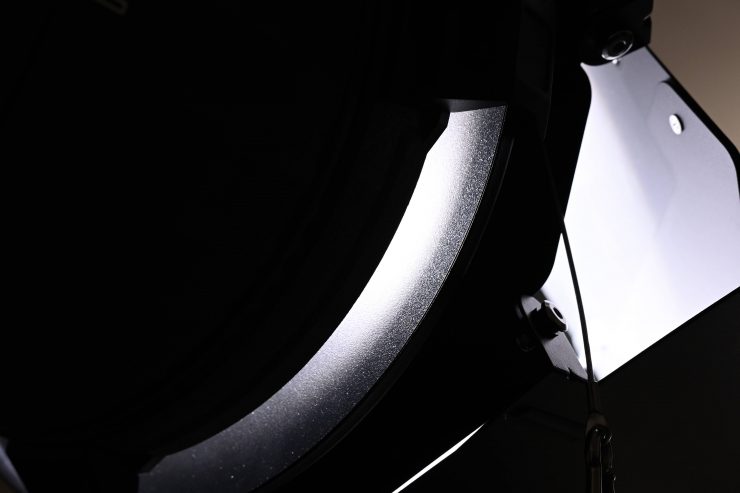
They also feature a built-in spill ring so you won’t get a lot of light coming out of the back where there shouldn’t be.
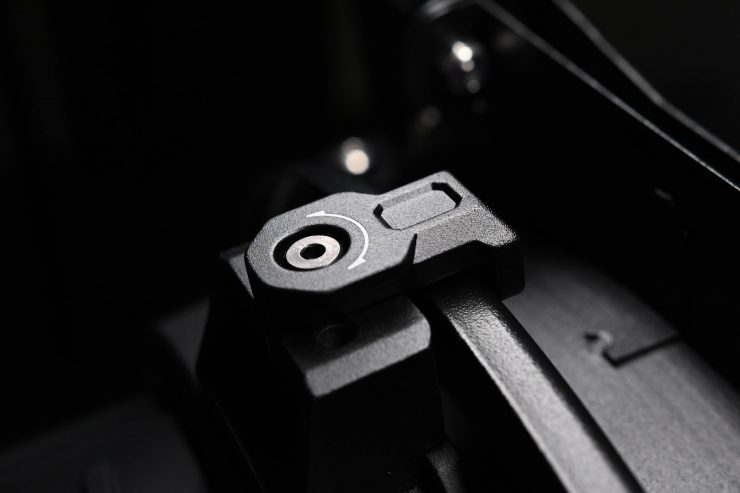
There is a nice secure and solid latching system for attaching the barn doors to the F10. For added safety, there is also a safety latch that you use.
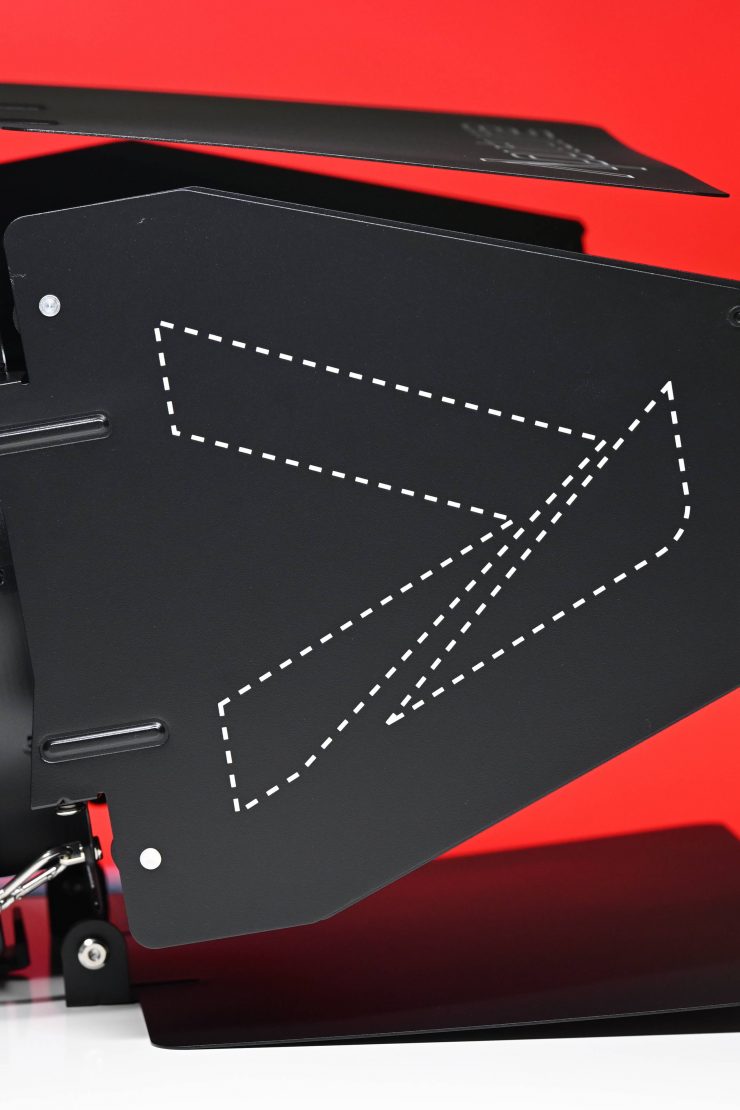
The quality and finish of the barndoors are excellent.
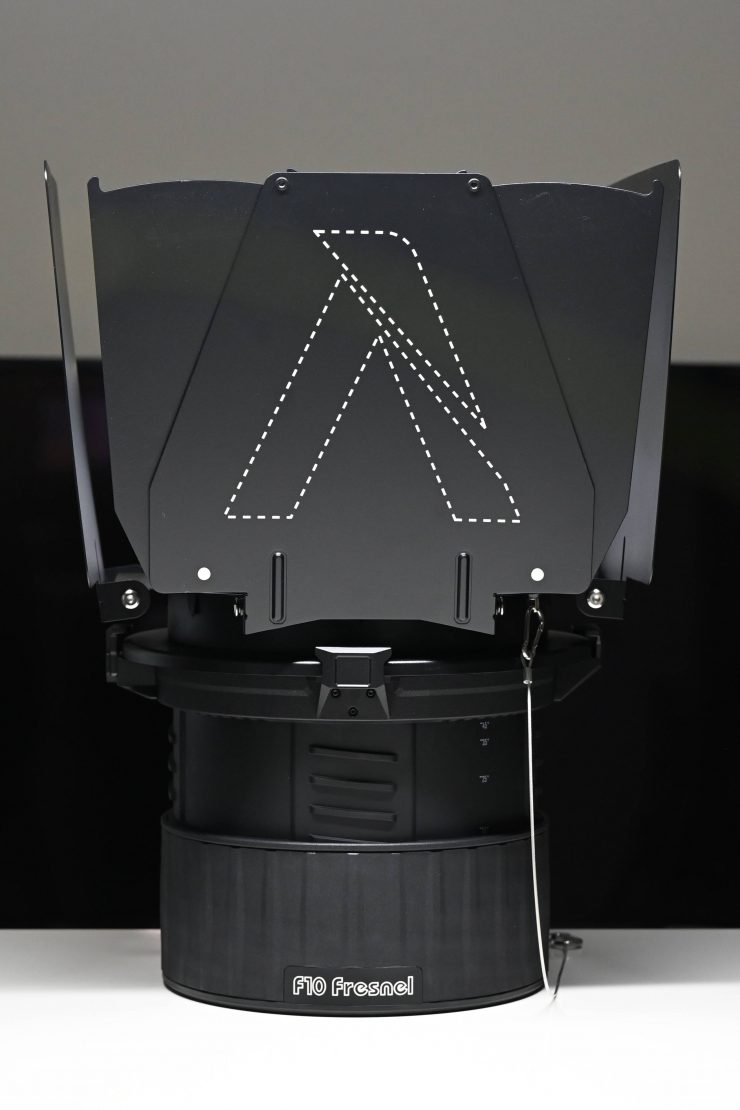
Just like the actual F10 Fresnel, the barndoors are physically quite large and heavy. The barn doors weigh in at 2.7kg (5.95 lb). They are around 40.5cm (15.94″) wide by 33cm (12.99″) high.
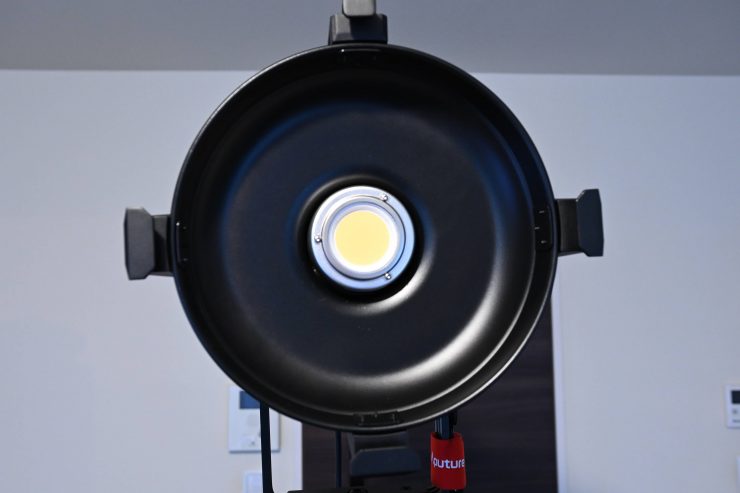
The 10” Metal Barndoors also comes with a separate attachment so you can place the barn doors onto the 600d Pro without having to use the F10 Fresnel.
What you clearly need to remember is that you are going to need an additional case or bag to carry the barndoors in. They don’t fit in the F10 Fresnel case or the 600d Pro’s case.
Now, these new barndoors won’t just work with the 600d Pro, they are also compatible with virtually any light that uses a Bowens mount, such as the,300d II, 300x, 120d II, etc.
Does it cut well?
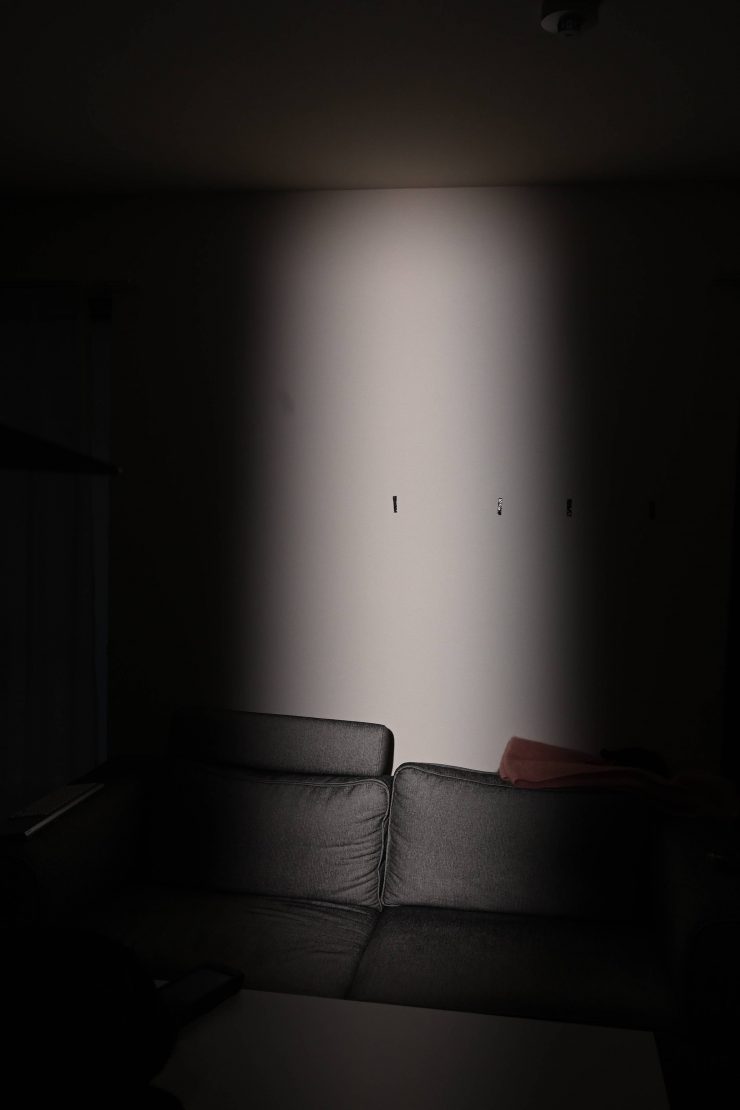
With the optional barndoors you can cut the light in a similar way to how you would if you were utilizing an HMI. This is a big deal because it is something a lot of other LED Fresnels struggle with. Above you can see some quick examples with the light set at 45°.
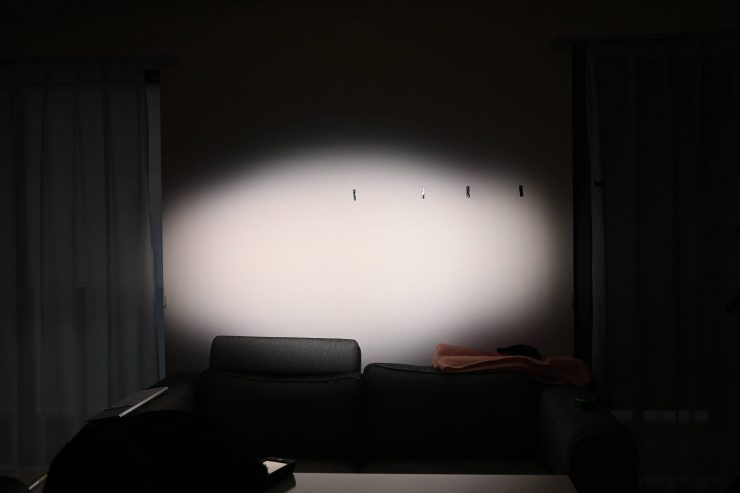
If you try using the F10 at 15° with the barndoors you will find that you can’t get a square or straight cut anymore and instead the cut will take on more of an oval appearance.
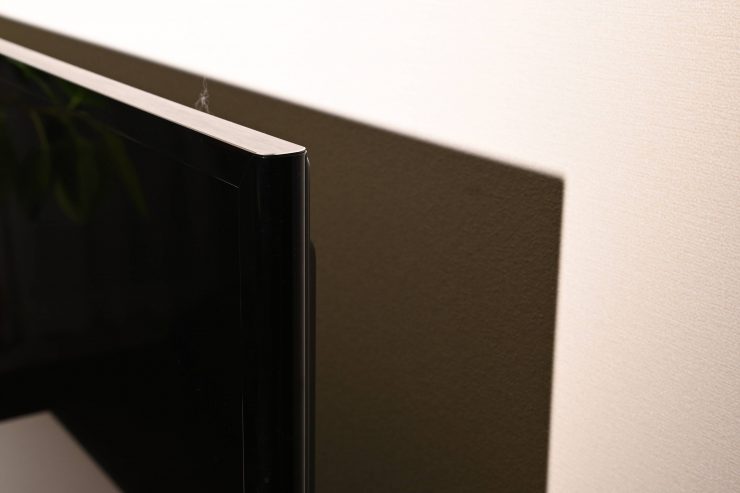

45° 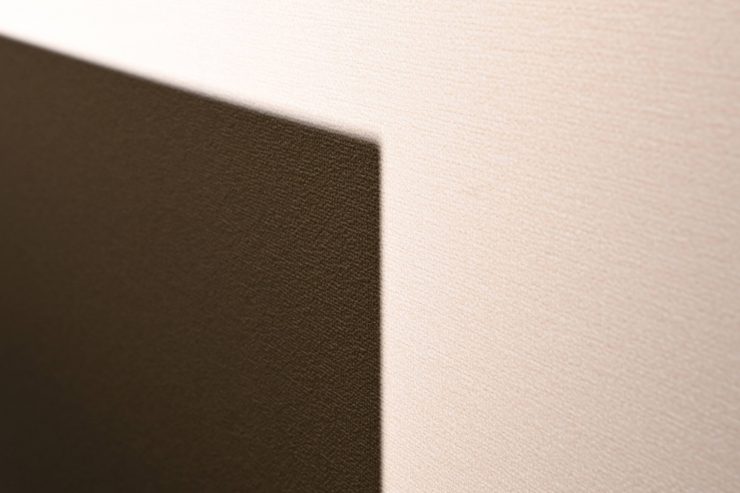
45° 
45° 
45°
The barn doors certainly work a lot better when you are using the F10 Fresnel at 45° or around 30-35°. You can get very clean-edged shadows.
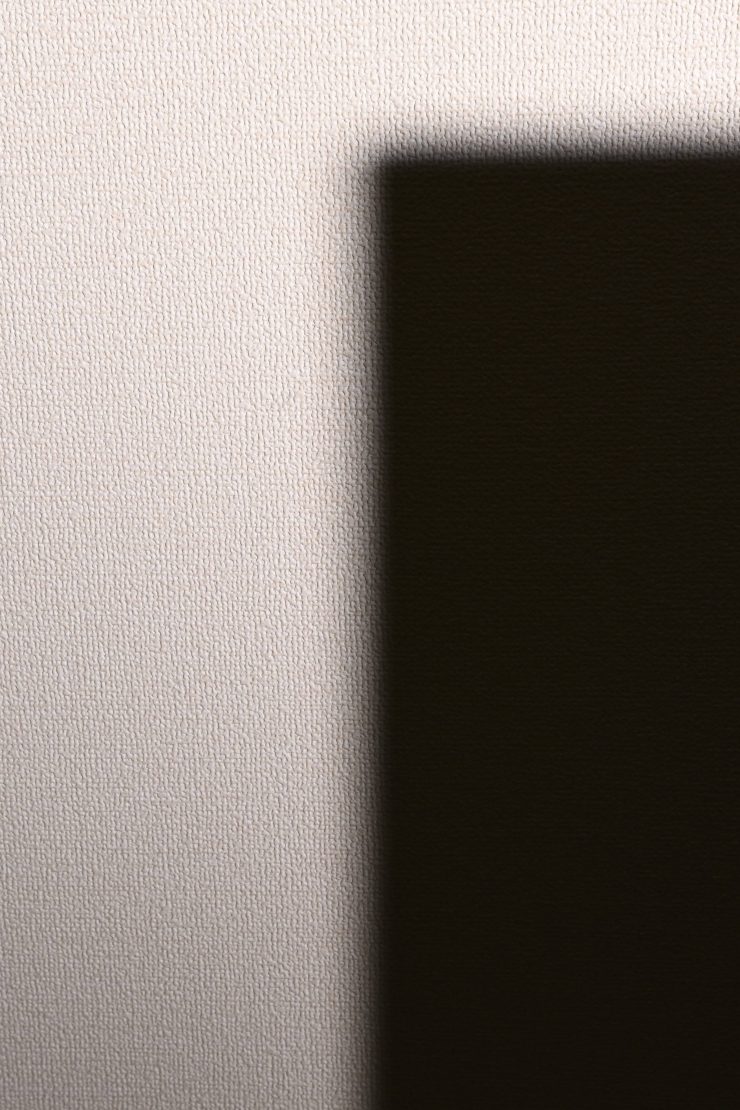

15° 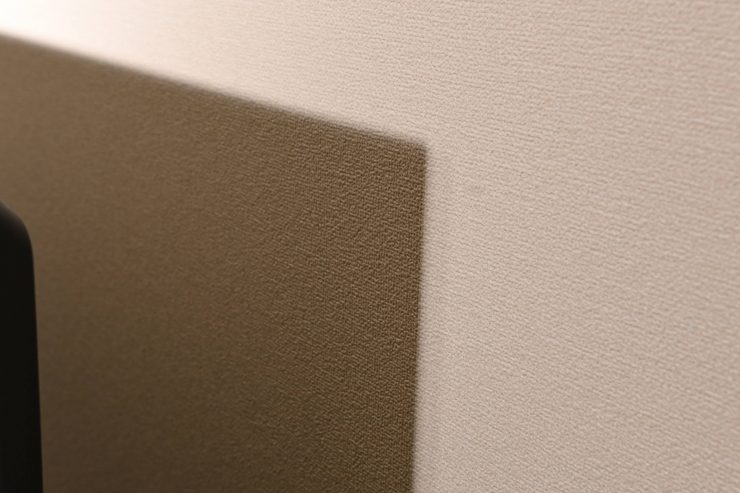
15° 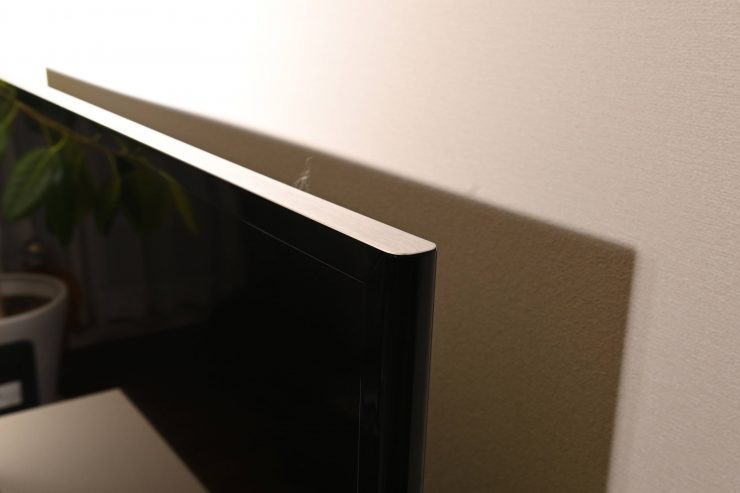

Above you can see that once you spot up the F10 to 15° to shadows aren’t quite as crisp.
Is there any color fringing?
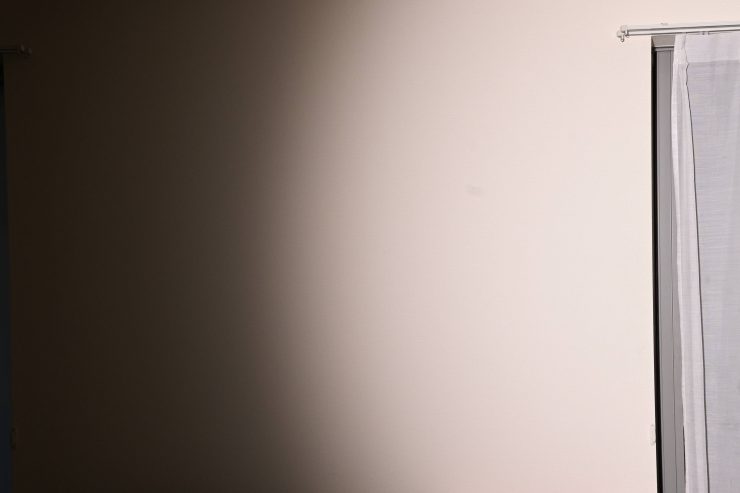

45° at 3m 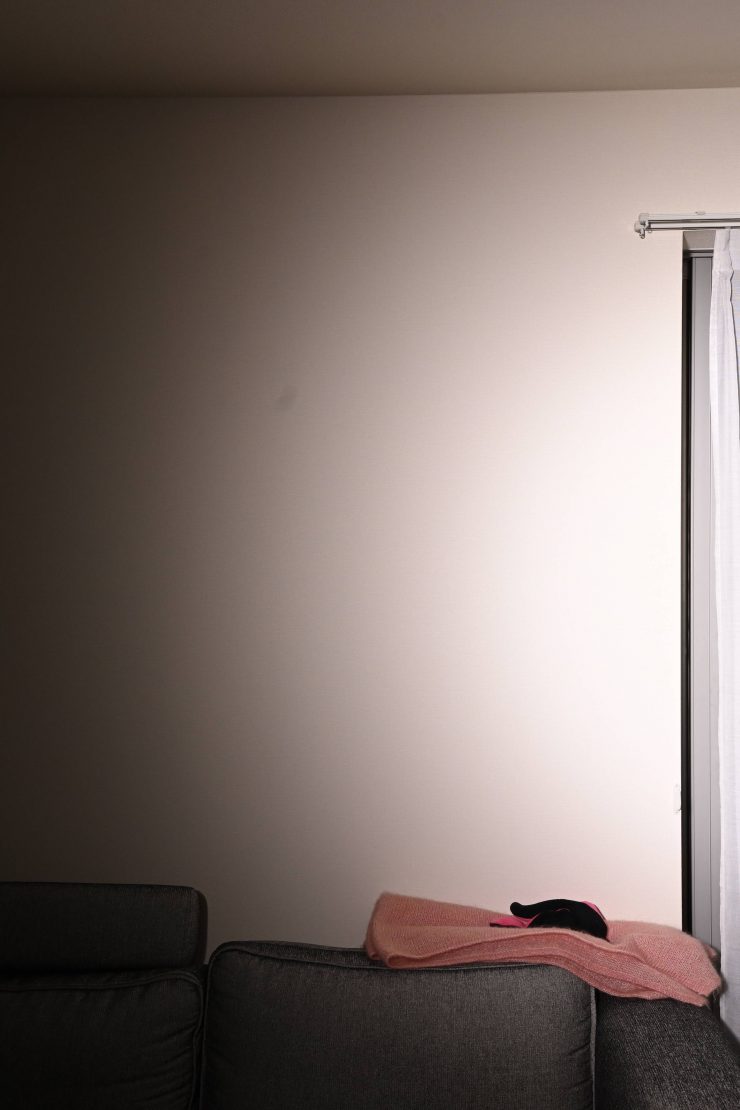
15° at 3m
I was impressed with the lack of color fringing I was seeing when using the F10 fresnel, especially at wider beam angles. There is a little bit of color fringing when using the F10 at 15°, but it isn’t too bad.
Output & Color Temperature Accuracy
A big factor for a lot of people when buying a light is how much output it can produce. I tested the lights output using it open face, with the hyper reflector, and with the F10 Fresnel Attachment using a Sekonic C-800 at a distance of 1m (3.28ft) in a controlled environment
All measurements were taken from the front of the attachment being used. All measurements were taken with the Sekonic C-800 at the exact same height and offset to where the middle of the light source was. Now, please bear in mind that this light and the F10 Fresnel does create a hot spot, so the readings in the center are going to be around 10% higher than they will off the sides of the beam angle.
Below you can see the results:
Open Face
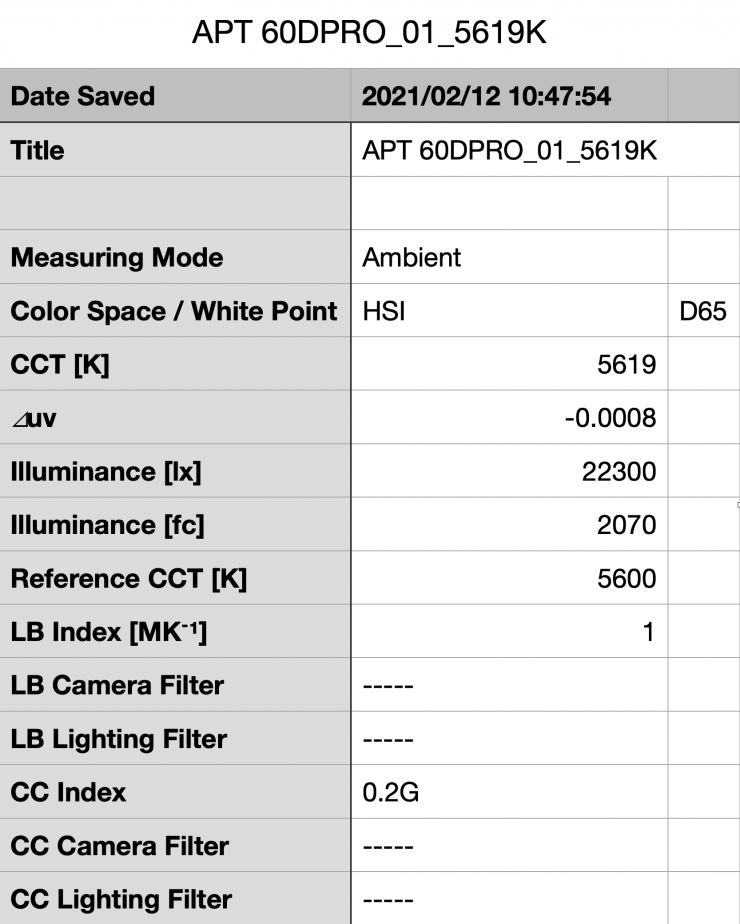
Above you can see the 600d Pro when used open face recorded an output of 22300 lx / 2070 (fc). This is a lot of output given how wide the beam angle is when using it open face.
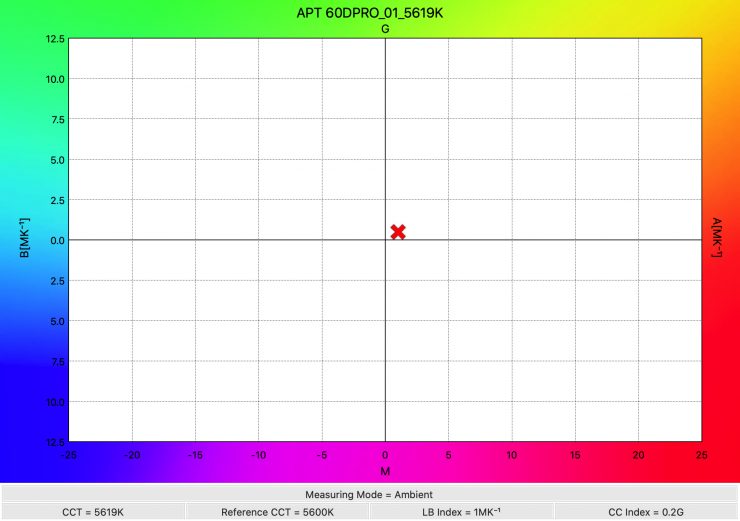
Used open face it produced a Kelvin color temperature of 5619K, which was a very good score.
Hyper Reflector
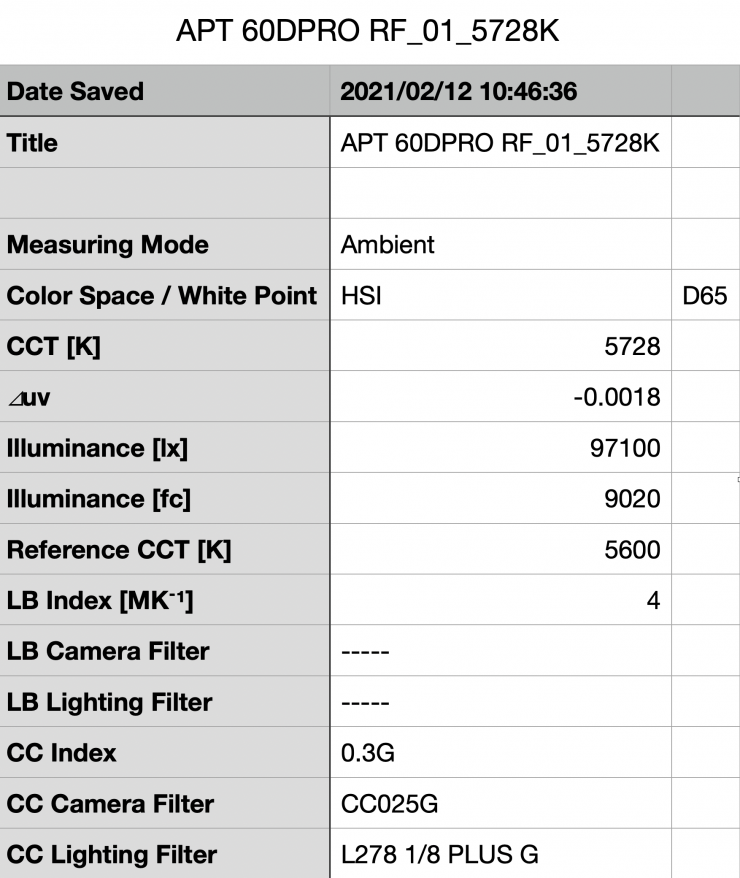
When used with the Hyper Reflector the 600d Pro had an output of 97100 lx (9020 fc). That was 77% more output compared to when the light is used open face. You need to take into account that with the hyper reflector the beam angle is getting narrowed quite a bit.
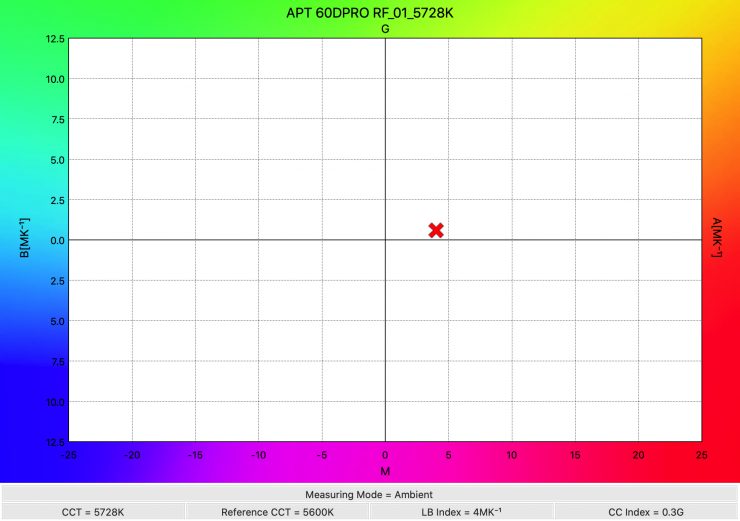
Used open face it produced a Kelvin color temperature of 5728K, which was higher than when the light was used open face. This tells me that the Hyper Reflector is affecting the Kelvin color temperature accuracy. This is something you need to keep in mind when using the Hyper Reflector
F10 Fresnel Attachment 45°
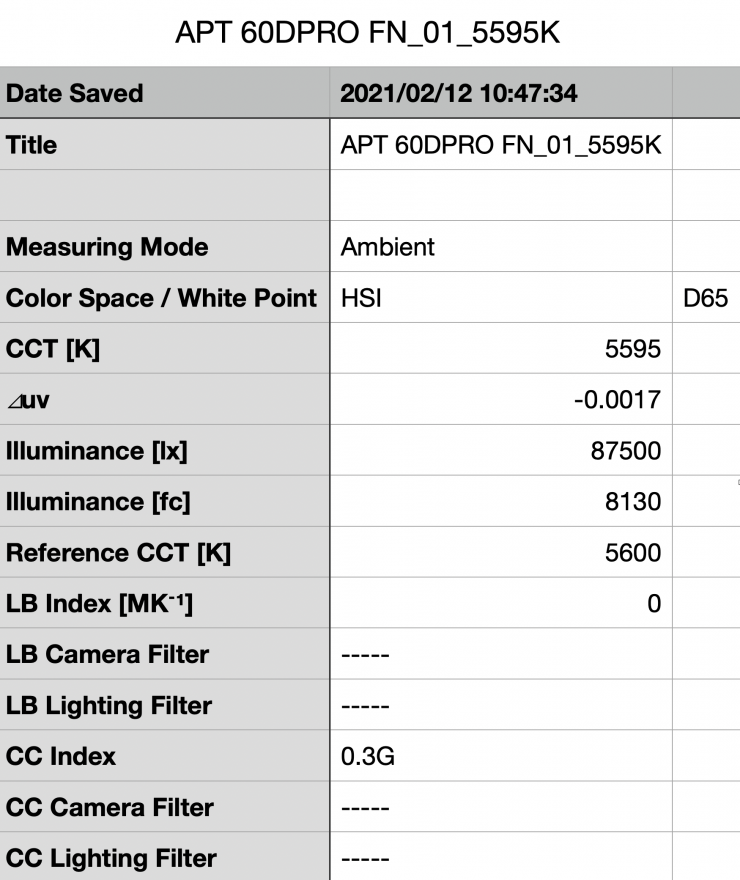
When used with the F10 Fresnel Attachment the 600d Pro had an output of 87,500 lx (8130 fc). That was 9.88% less output compared to when the light is used with the Hyper Reflector.
As a comparison, something like a 2.5K HMI is probably only going to be around 20% brighter. This gives you an idea of just how bright the 600d Pro with the F10 Fresnel is.
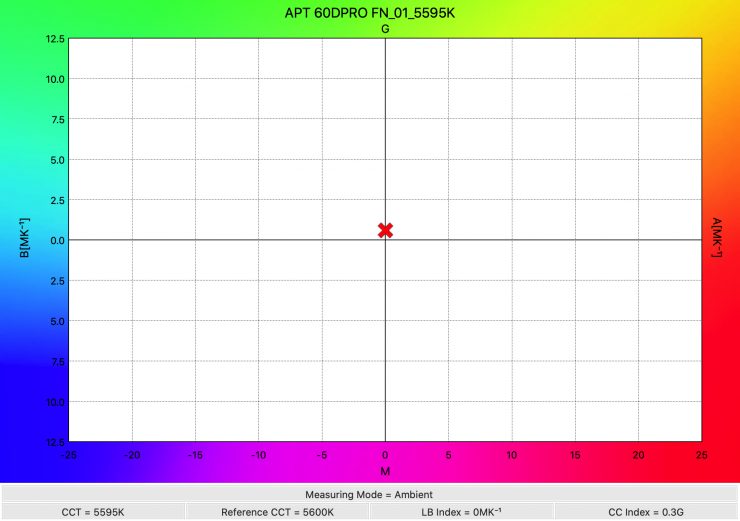
Used with the F10 Fresnel Attachment the light produced a Kelvin color temperature of 5595K, which was was a lot more accurate than when the fixture was used with the Hyper Reflector. This tells me that F10 Fresnel Attachment actually gives you the most Kelvin color temperature accurate way of using the 600d Pro.
F10 Fresnel Attachment 35°
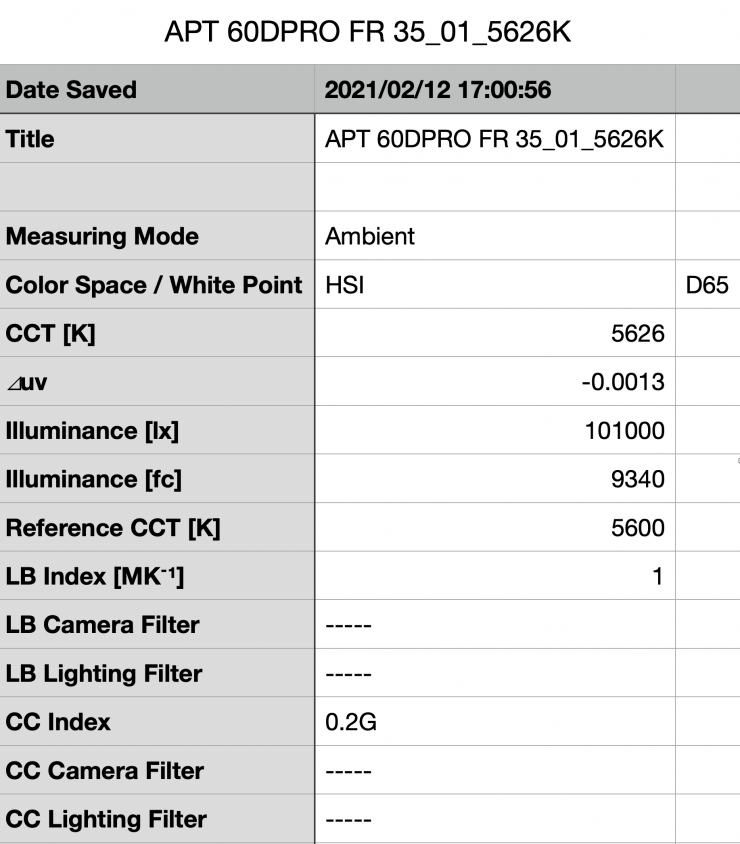
When used with the F10 Fresnel Attachment the 600d Pro had an output of 101,100 lx (9340 fc) when set at 35°. As a comparison, the 1800W ARRI M18, when used at 39° puts out around 212,000 lx at 1m.
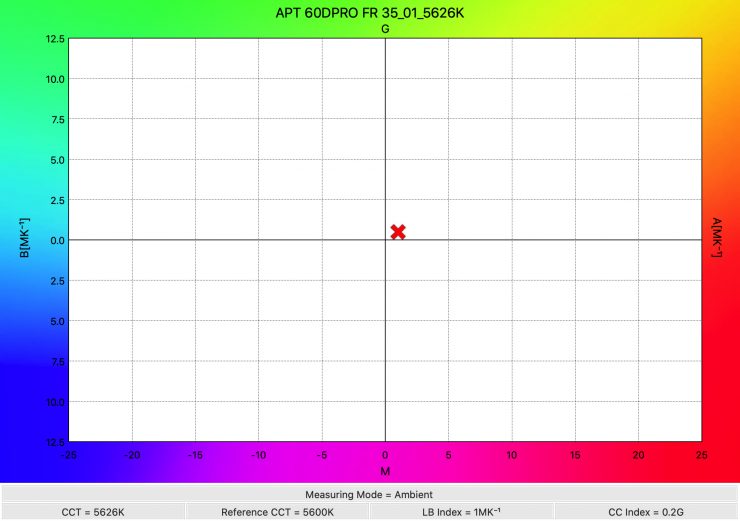
Used with the F10 Fresnel Attachment at 35° the light produced a Kelvin color temperature of 5626K.
F10 Fresnel Attachment 20°
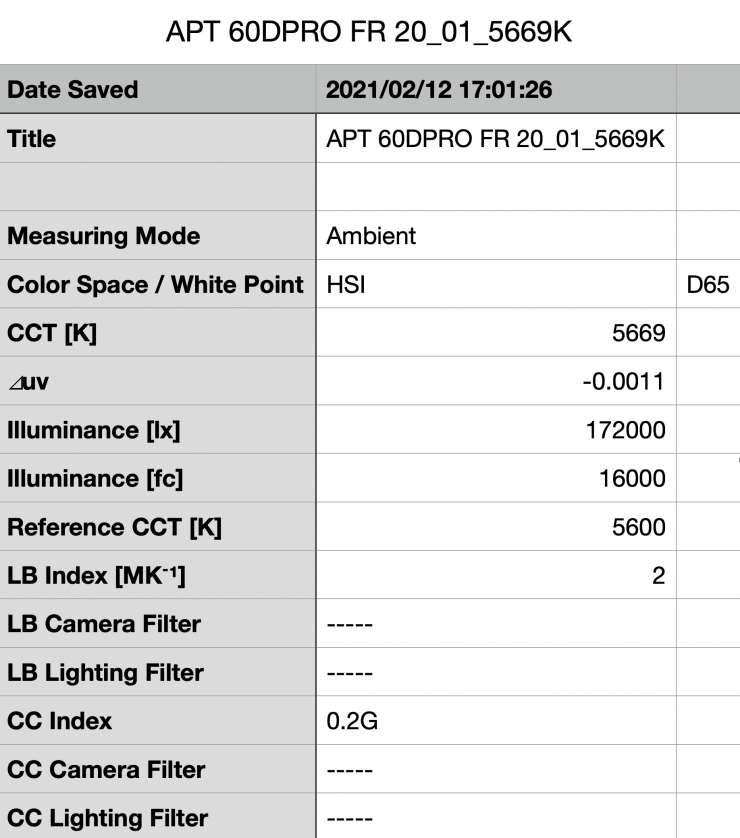
When used with the F10 Fresnel Attachment the 600d Pro had an output of 172,000 lx (16000 fc) when set at 20°.
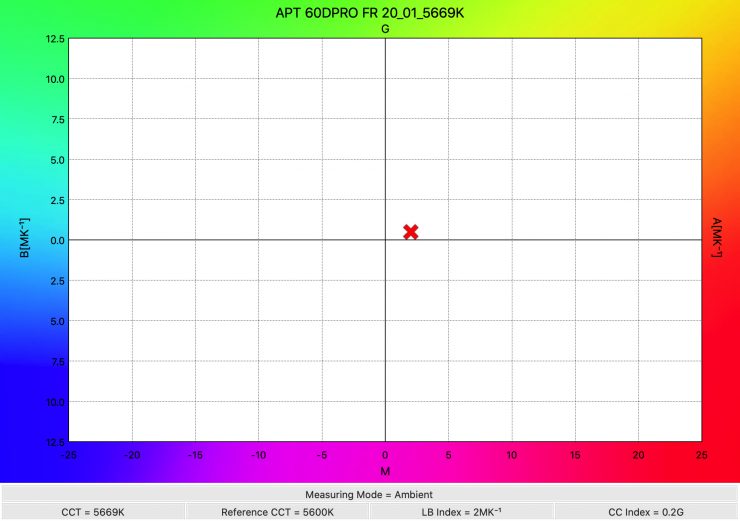
Used with the F10 Fresnel Attachment at 35° the light produced a Kelvin color temperature of 5669K.
F10 Fresnel Attachment 18°
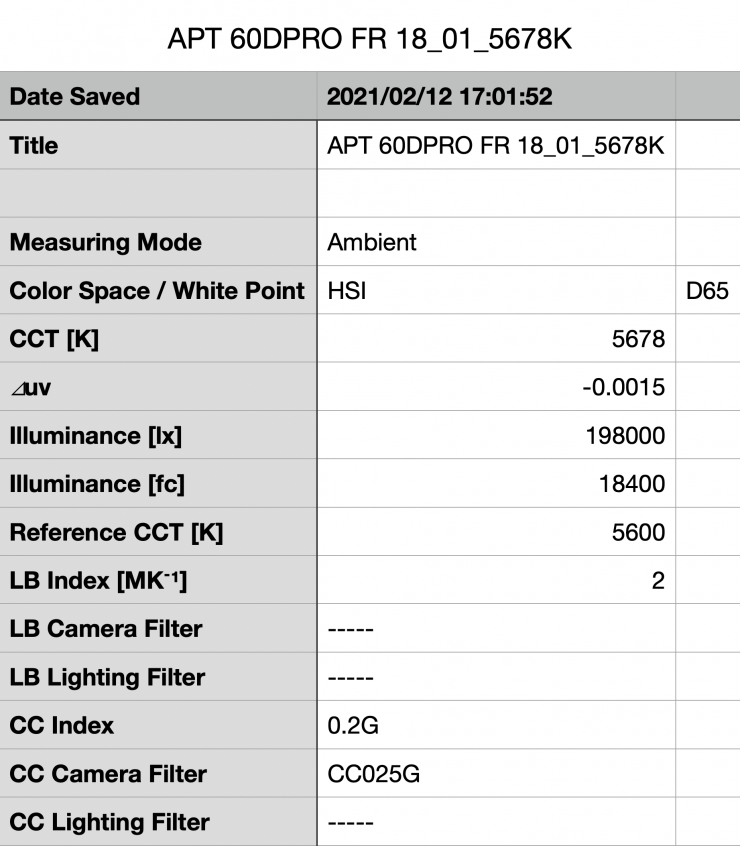
When used with the F10 Fresnel Attachment the 600d Pro had an output of 198,000 lx (18400 fc) when set at 18°.
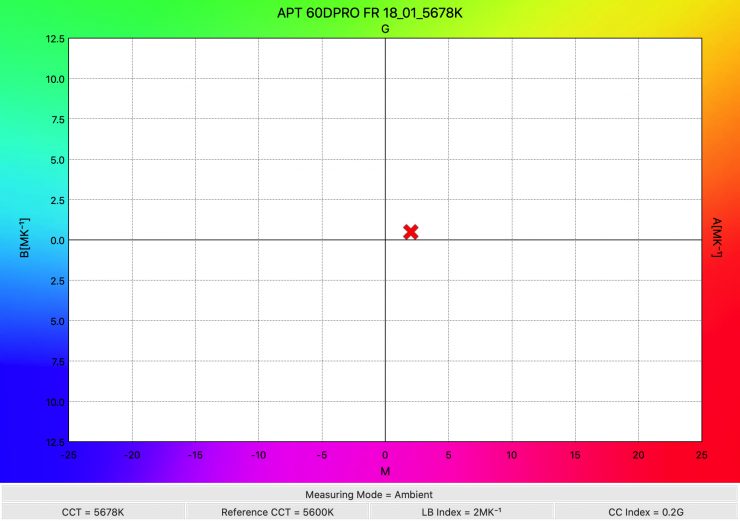
Used with the F10 Fresnel Attachment at 18° the light produced a Kelvin color temperature of 5678K.
F10 Fresnel Attachment 15°
Now, I had to do this measurement at a distance of 3m (9.84ft) as the Sekonic C-800 only measures up to 200,000 lx and at a distance of 1m the reading was way over that.
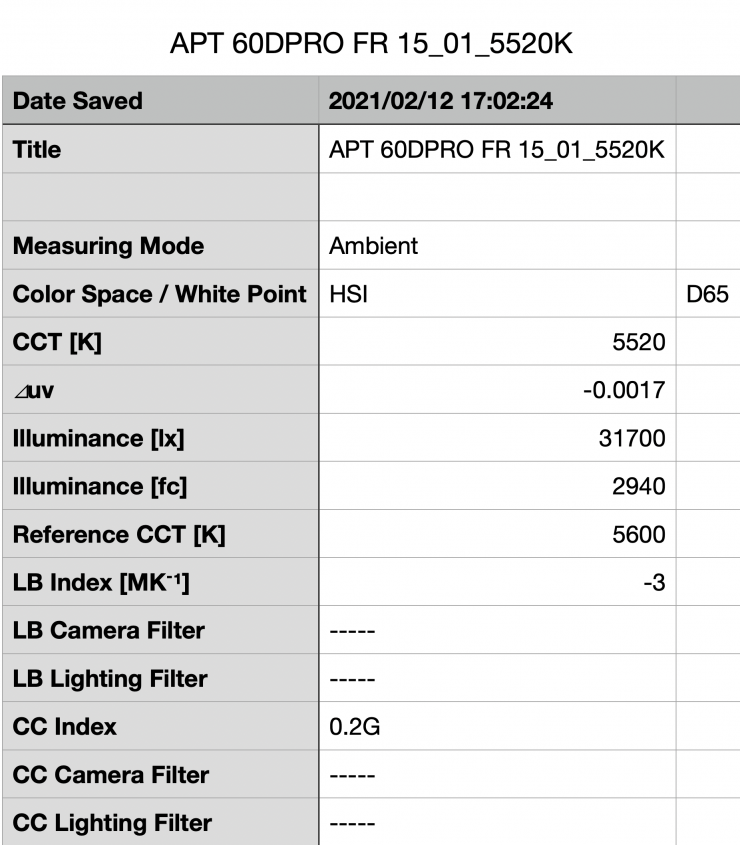
When used with the F10 Fresnel Attachment the 600d Pro had an output of 31700 lx (2940 fc) when set at 15°. If my calculations are correct, that means that the light would have more than 340,000 lx at a distance of 1m.
As a comparison, an ARRI M18 when used at 16° puts out around 109,000 lx at 3m.
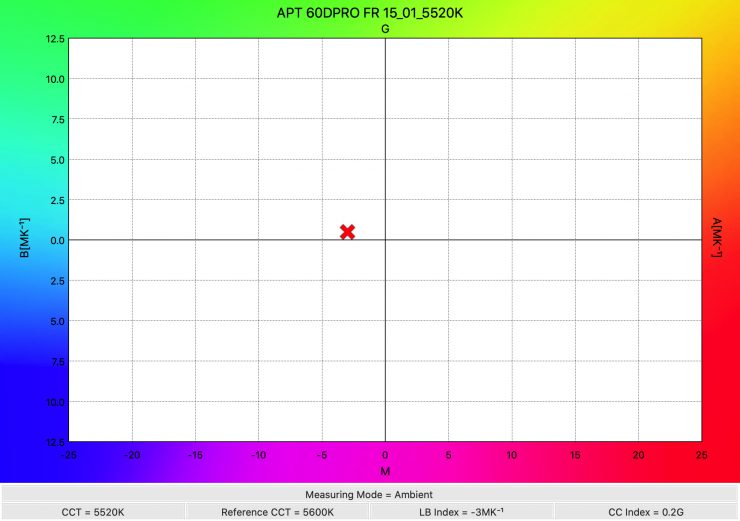
Used with the F10 Fresnel Attachment at 15° the light produced a Kelvin color temperature of 5678K.
Summary of results
| ATTACHMENT | OUTPUT | KELVIN COLOR TEMPERATURE |
| Open Face | 22300 lx | 5619K |
| Hyper Reflector | 97100 lx | 5728K |
| F10 Fresnel 45° | 87500 lx | 5595K |
| F10 Fresnel 35° | 101100 lx | 5626K |
| F10 Fresnel 20° | 172000 lx | 5669K |
| F10 Fresnel 18° | 198000 lx | 5678K |
| F10 Fresnel 15° | Over 340,000 lx* | 5520K |
*Estimation based on inverse square lighting law
How is the fall off?
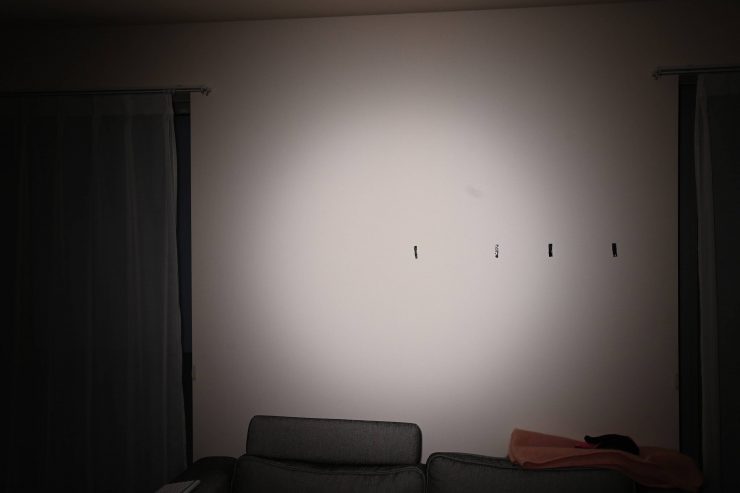
I took a series of measurements at distances away from the center of the beam when using the F10 at 15° and 45° to see how linear the fall off was and if there were any hotspots.
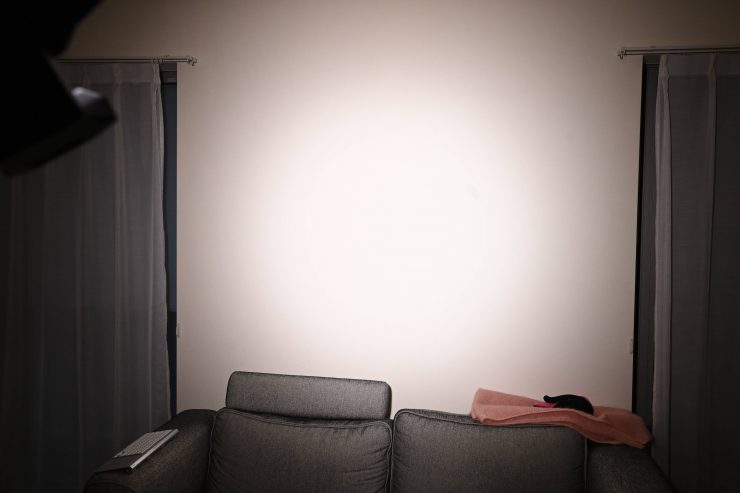
The F10 definitely creates a hot spot in the middle, especially at 15°.
| DISTANCE FROM CENTER | LUX |
| Dead Center | 33600 lx |
| 30cm from center | 30600 lx |
| 50cm from center | 16600 lx |
| 75cm from center | 4650 lx |
Above you can see lux readings taken at the corresponding distances from the center of the beam at a distance of 3m when the light was used at 15°. You can see that the hotspot in the middle is around 9% brighter than if you take a reading 30cm to the left or right.
The intensity of the light then starts to drop away quite dramatically from 30cm to 50cm away from the center of the beam.
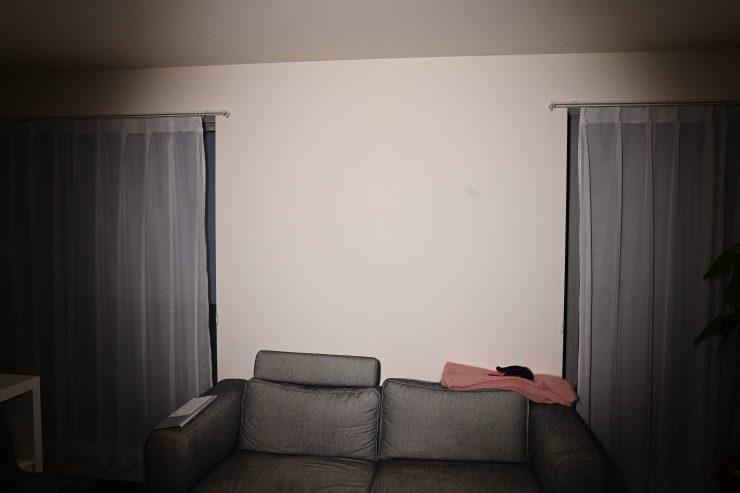
| DISTANCE FROM CENTER | LUX |
| Dead Center | 12300 lx |
| 30cm from center | 12000 lx |
| 50cm from center | 11400 lx lx |
| 75cm from center | 10100 lx |
| 1m from center | 7390 lx |
| 2m from center | 549 lx |
Above you can see lux readings taken at the corresponding distances from the center of the beam at a distance of 3m when the light was used at 45°.
At a distance of 3m when used at 45° the F10 has a fairly good spread of light out to about 75cm from the center. The disadvantage the F10 has when compared to a lot of HMI fixtures is that they can usually go out to around 65°. That does allow you to create a much wider light source which is handy if you are in smaller spaces.
CC Index & ⊿uv
The CC Index displays the CC correction value and whether any magenta or green need to be added or subtracted. 1 CC corresponds to 035 Kodak CC values or 1/8 Rosco filter values. Any reading less than +1.00 or -1.00 and you’re probably not going to need to make any kind of adjustment. The ⊿uv is the value to show how much this light is away from being an ideal light source (black body radiation = incandescent lamp). As with the CC Index you want this number to theoretically be zero. Kelvin is not a linear value, so we need to convert from Kelvin to MK-1 to compare the values of color temperature. To calculate from Kelvin to Mired is MK-1= 1*1000000/Kelvin. While this may sound confusing, it is the only way of measuring if the Kelvin shift is significant enough to warrant having to use a filter for correction. Below are the results for the Aputure when using the F10 Fresnel Attachment at 45°.
Kelvin Vs MK-1
| Kelvin | Difference in K | MK-1 | Difference in MK-1 | |
| SET VALUE | 5600K | 0 | 178.57 | 0 |
| ACTUAL READING | 5595K | 5 | 178.73 | 0.16 MK-1 |
These figures might look confusing, but what it tells me is that the light is exceptionally Kelvin color-accurate when used with the F10 Fresnel. Any MK-1 score that is under -9/9 means you wouldn’t have to use any color correction gels.
CC INDEX & ⊿uv
| CC INDEX | ⊿uv | |
| 5600K | 0.3G | -0.0017 |
These results show me that the light does have a small skew towards green, but it is fairly marginal.
Does the light’s Kelvin color consistency change once it is dimmed down?
With a lot of LED lights, the Kelvin color temperature can change significantly once you start dimming the fixture down. So how does the 600d Pro with the F10 Fresnel fare? Below you can see the performance of the light.
| CCT | |
| 100% Output | 5595K |
| 75% Output | 5588K |
| 50% Output | 5560K |
| 25% Output | 5559K |
| 10% Output | 5532K |
| 5% Output | 5499K |
As you can see the light’s Kelvin color temperature does not alter in any significant way when it is dimmed down especially to around 25%. Once you get below 25% there is a slight dip in the Kelvin color temperature, but it is marginal.
How linear is the output?
I wanted to see how linear the light’s output was when using the F10 Fresnel, so I tested it at a variety of intensities. Below you can see the results.
| lx | |
| 100% Output | 87500 lx |
| 75% Output | 66600 lx |
| 50% Output | 46500 lx |
| 25% Output | 26400 lx |
| 10% Output | 14300 lx |
| 5% Output | 10300 lx |
The results show me that the light’s output is reasonably linear once you start dimming the fixture down. At 50% output, it had 46.8% less output than when it was used at 100% output.
Color Rendering
F10 Fresnel
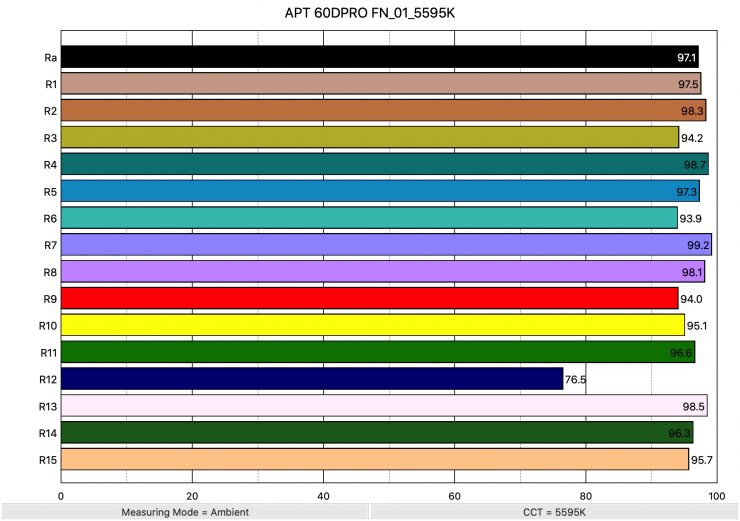
So now that we have seen how much output the 600d Pro produces, how does it perform when it comes to replicating accurate colors. Above you can see that when the light was using the F10 Fresnel recorded an average CRI (R1-R8) of 97.1 and an extended CRI (R1-R15) of 95.32. For replicating accurate skin tones it recorded 94 R9 (red), 98.5 for R13 (closest to caucasian skin tones), and 95.7 for R15 (closest to Asian skin tones). These are good results.
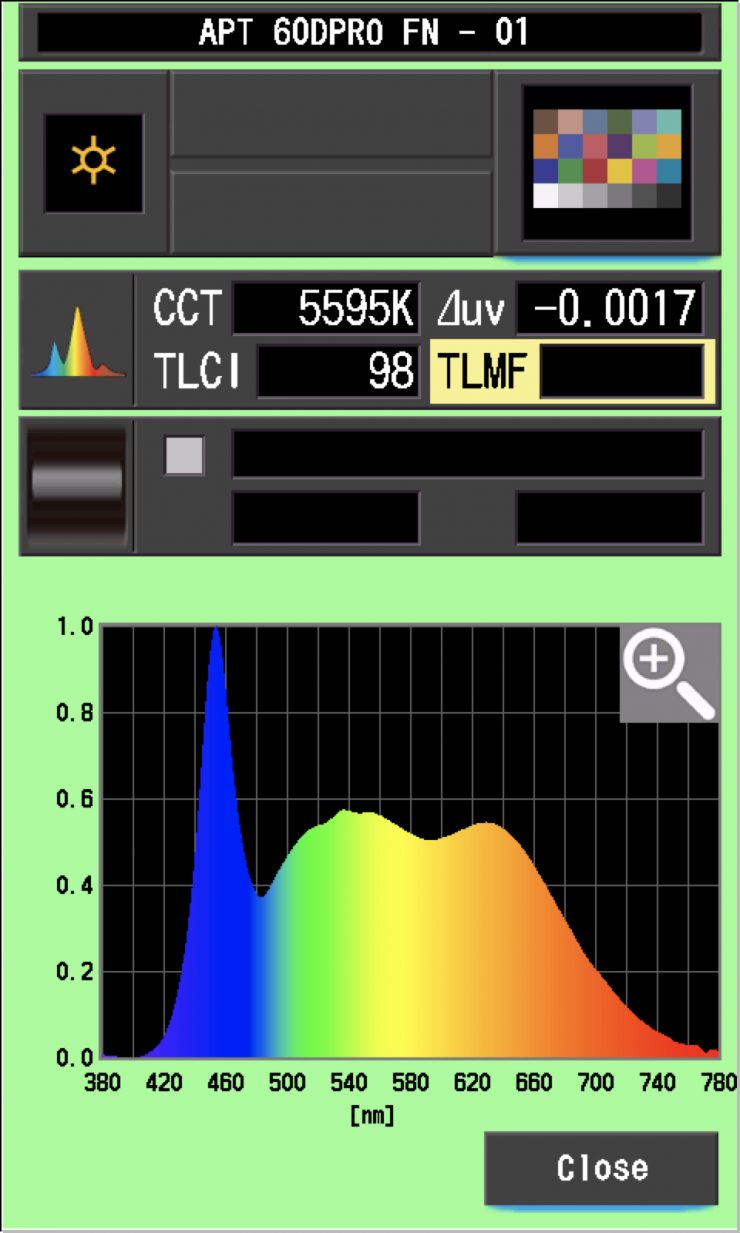
The light when used with the F10 Fresnel also recorded a TLCI score of 98.
Hyper Reflector
Just as a comparison, I decided to check the color rendering of the 600d Pro when it was used with the Hyper Reflector.
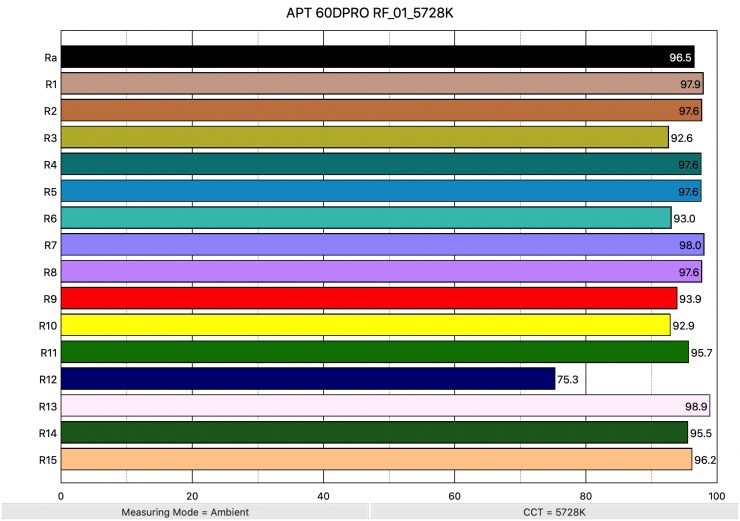
Above you can see that when the light was using the Hyper Reflector recorded an average CRI (R1-R8) of 96.5 and an extended CRI (R1-R15) of 95.32. For replicating accurate skin tones it recorded 93.9 R9 (red), 98.9 for R13 (closest to caucasian skin tones), and 96.2 for R15 (closest to Asian skin tones). These are good results.
| CRI | EXTENDED CRI | R9 | R13 | R15 | |
| M10 Fresnel | 97.1 | 97.54 | 94.0 | 98.5 | 95.7 |
| Hyper Reflector | 96.5 | 94.68 | 93.9 | 98.9 | 96.2 |
Above you can see that the light remains relatively consistent when used with the Hyper Reflector or the F10 Fresnel, however, the extended CRI scores are higher when using the F10 Fresnel.
TM-30
TM-30 is a relatively new color rendering standard that was developed to deal with the limitations of CRI. TM-30 looks at 99 individual colors. These 99 colors are categorized into seven groups: nature, skin color, textiles, paints, plastics, printed material, and color systems.
TM-30 scores go from 0 – 100. The higher the score, the more accurate a light is at producing colors. Any TM-30 Rf score in the ’90s is considered to be good. What is interesting and something that you need to be very aware of is that two separate light sources with the exact same CRI scores can render colors very differently. A light with a high CRI rating could have a low TM-30 score. Conversely, a light with a good TM-30 score could have a bad CRI score.
Now, there are two measurements associated with TM-30, Rf and Rg.
- Rf (Color Fidelity)
- Rg (Color Gamut)
With Rg value, a score below 100 indicates that the light source renders colors with less saturation than the reference source. So ideally you want this score to be above 100.
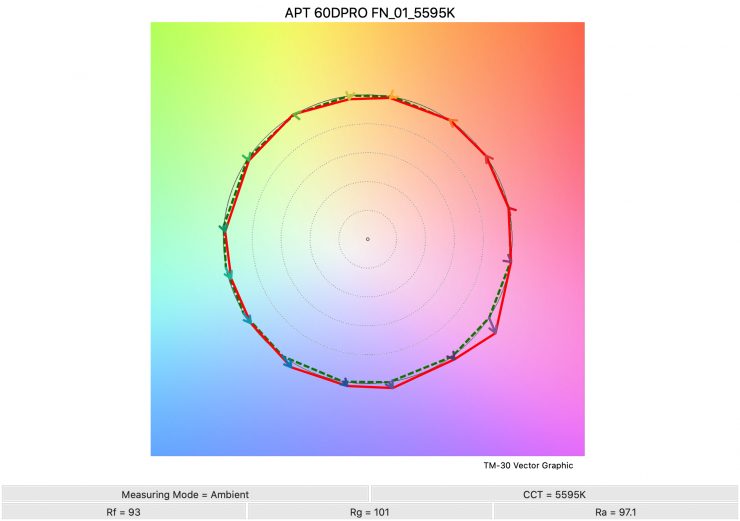
Above you can see the scores for the 600d Pro with the F10. It recorded a TM-30 Rf score of 93 and a TM-30 Rg score of 101.
SSI
SSI (Spectral Similarity Index) was developed by the Sci-Tech Council of the Academy. SSI gives me the ability to set any light as a standard, or use predefined standards (such as CIE D55), and then give other lights an SSI score based upon how well they will match standards such as CIE D55 measure spectral response and compare it directly against an ideal light source.
SSI is a much better way to judge an LED light than CRI or TLCI.
SSI is useful to see how well different lights will play together. As the Sekonic C-800 Spectromaster can measure SSI, I decided to test out the Intellytech to see how it performed.
F10 Fresnel
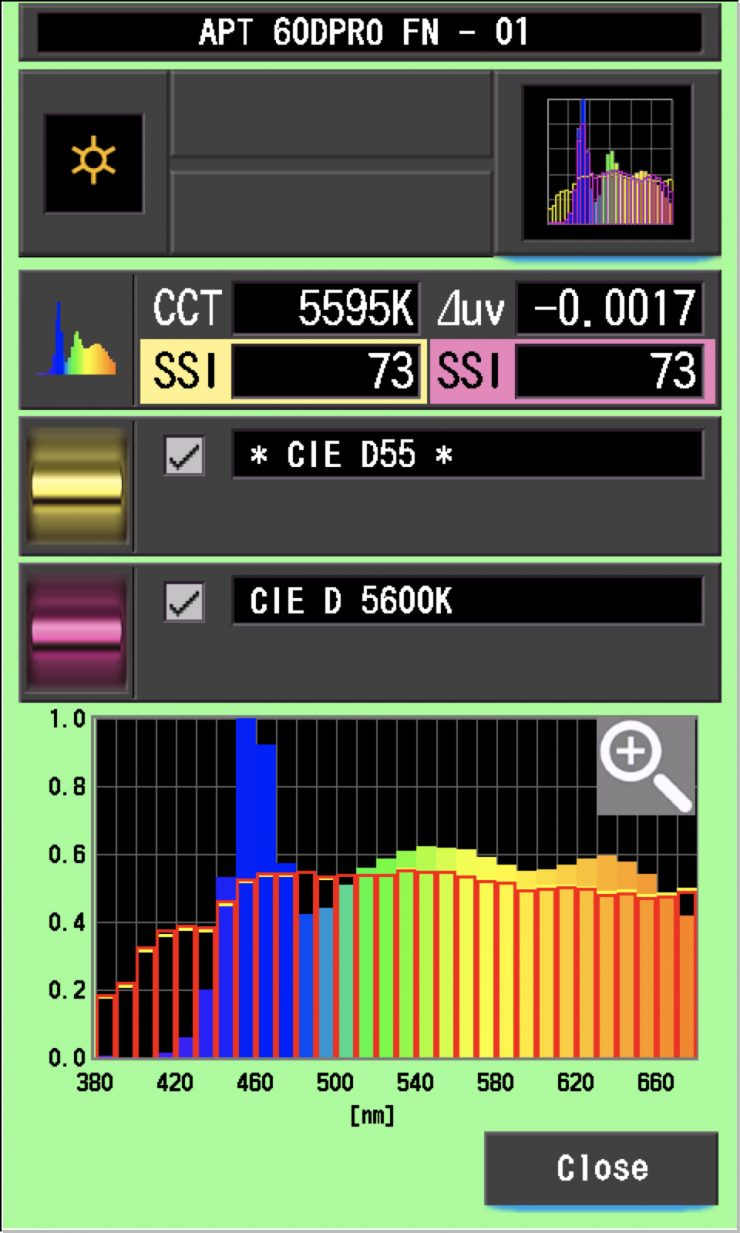
The scores show that the light does a reasonably good job of accurately replicating a CIE D55 source. A score in the low to mid-70s is very typical for a 5600K LED light.
The main reason we want to record SSI scores is so we can see how well they match with other lights. I was curious to see how well the 600d Pro with the F10 Fresnel matched the ARRI Orbiter and Prolychy Orion 300. These are two very color accurate lights, so it will be interesting to see how well the 600d Pro matches. Below you can see the results.
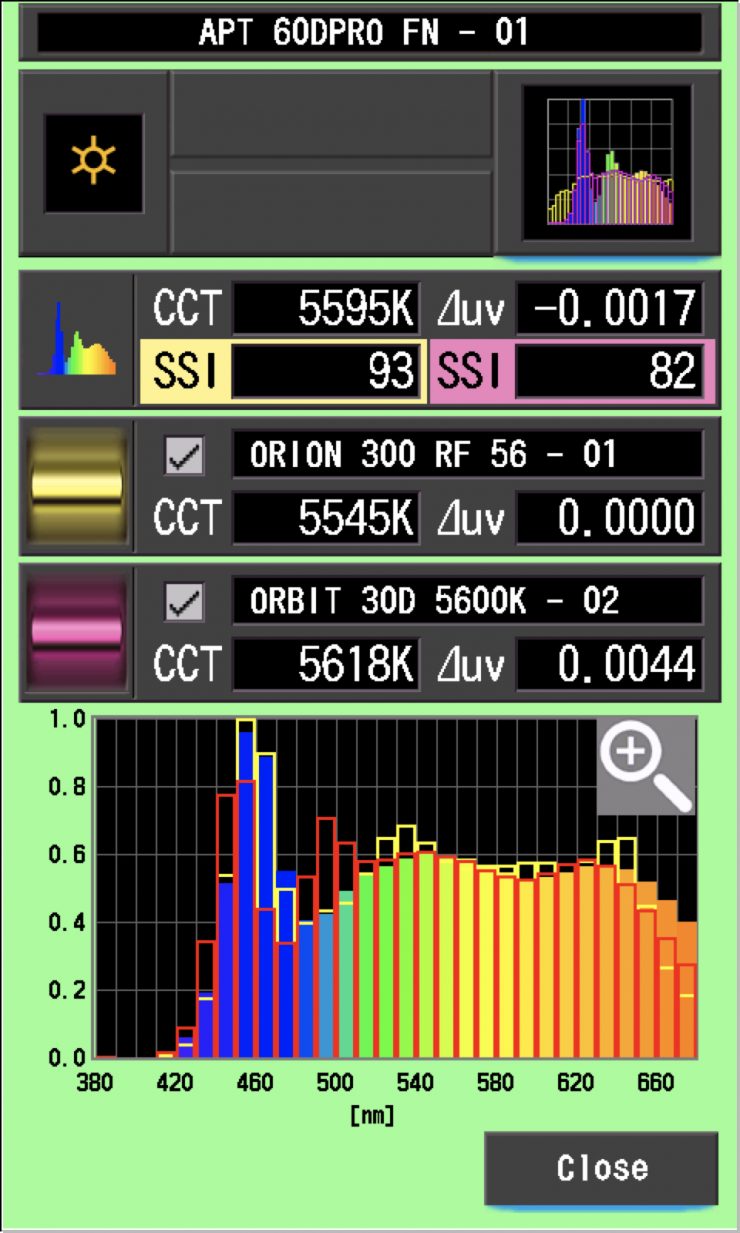
As you can see the 600d Pro and the other two lights are not a perfect match. However, a score in the high 80’s or low 90’s isn’t that bad and with a bit of tweaking, you could probably get the Prolycht Orion 300 to match reasonably well. It wouldn’t match that well when used with an ARRI Orbiter.
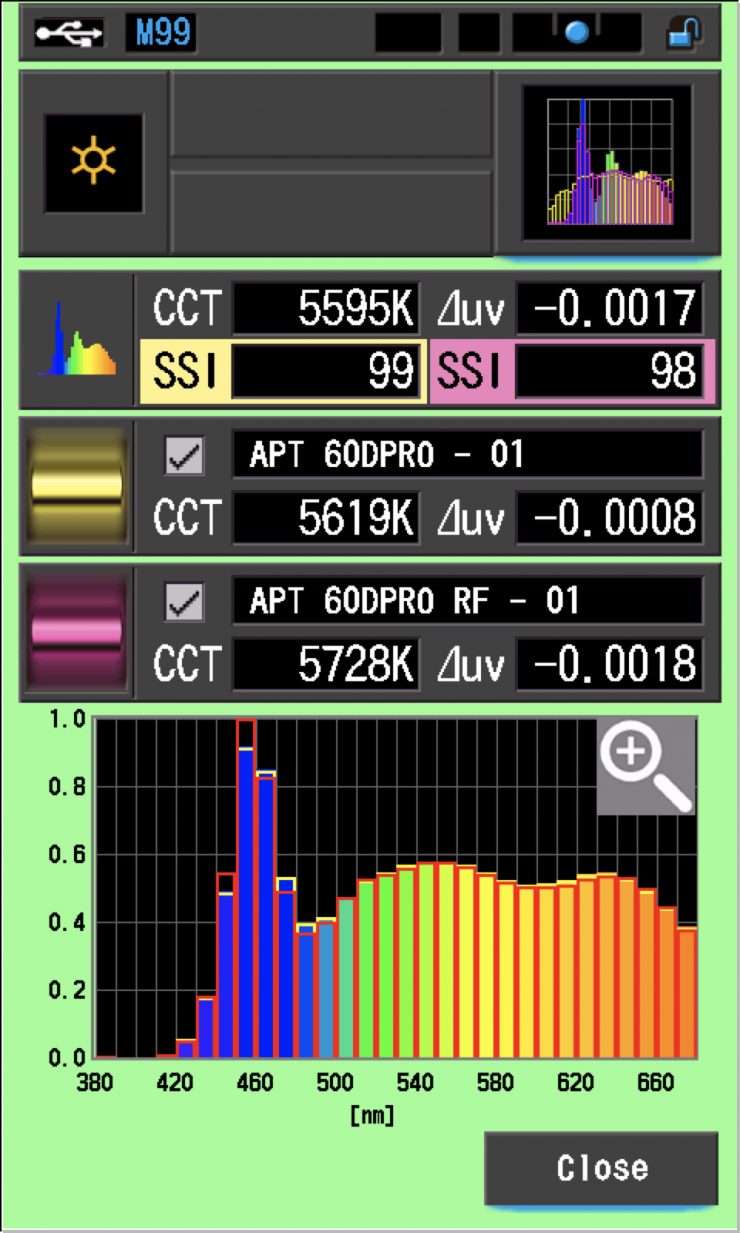
So, let’s see how well the 600d Pro with the F10 Fresnel matches the 600d Pro when used Open face and with the Hyper Reflector. As you can see, they all match very well and this gives me the knowledge that you could use three of these lights with various attachments with no real-world perceivable difference. In saying that, I can’t guarantee consistency. The same light from the same manufacturer can sometimes give you different readings.
Being able to measure SSI in advance and compare different lights you may be using together is a great way of finding out what lights will work together and what adjustments need to be made.
Spectral Distribution
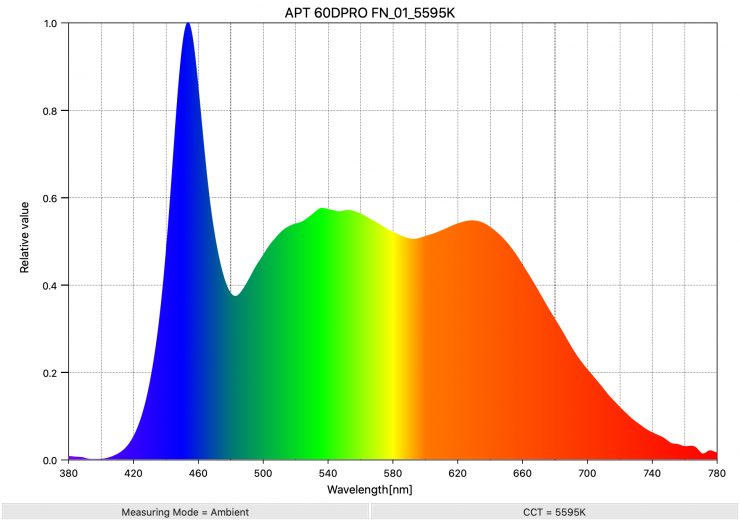
Above you can see the spectral distribution of the 600d Pro when used with the F10 Fresnel Attachment. The spectral distribution is not overly full, but then again this is not an RGBWW fixture.
Real-World Usability
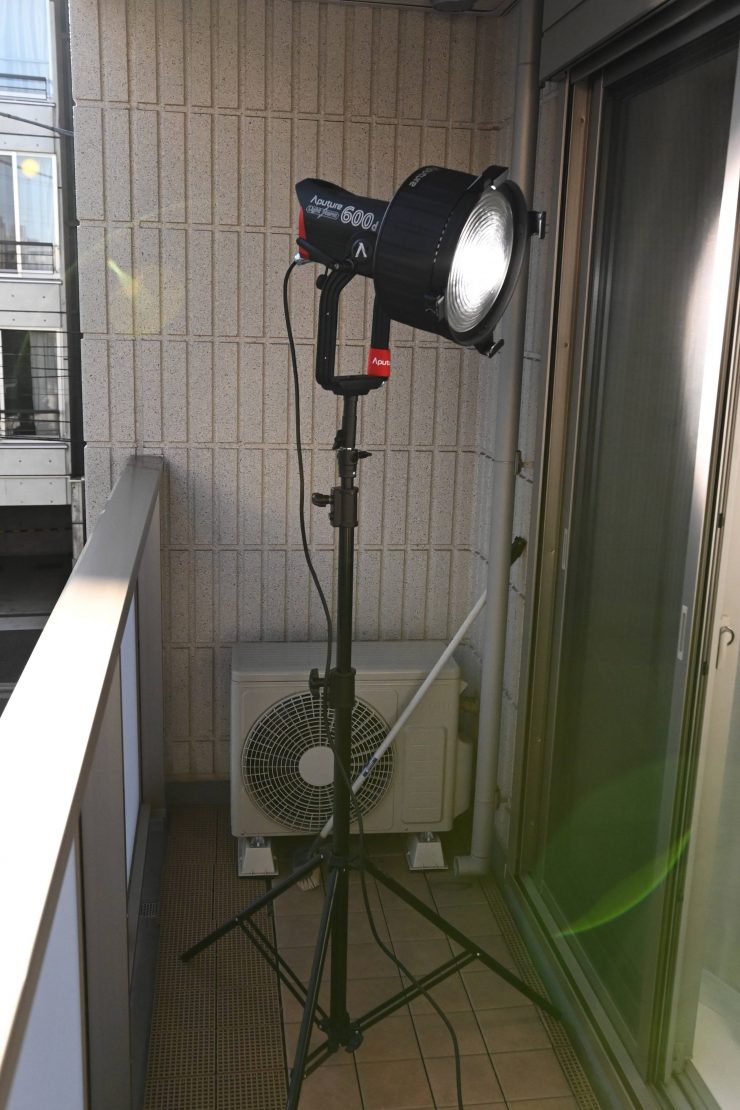
The 600d Pro and the F10 Fresnel is more than capable of replicating sunlight coming through a window. I used this combination on a recent shoot and it had more than enough output to easily simulate bright sun coming through a window. Unfortunately, I can’t show that vision as the project is still ongoing.
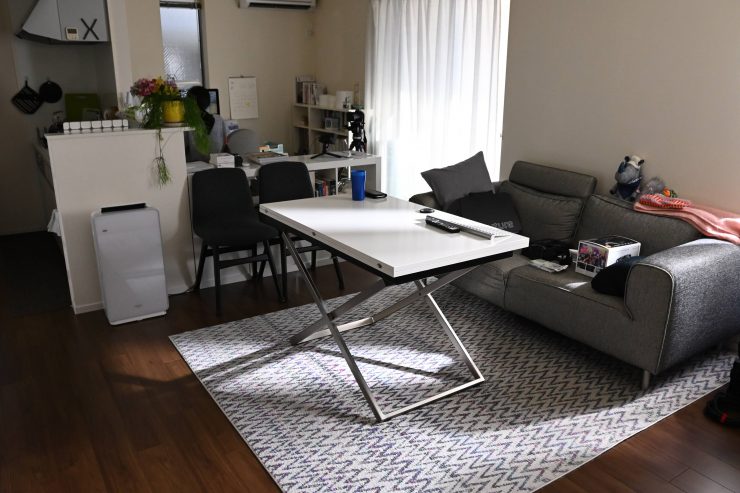

F10 Fresnel at 45° 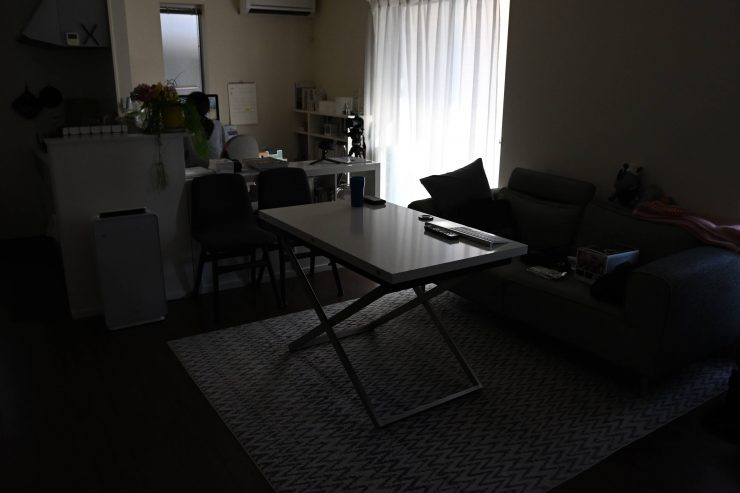
No light
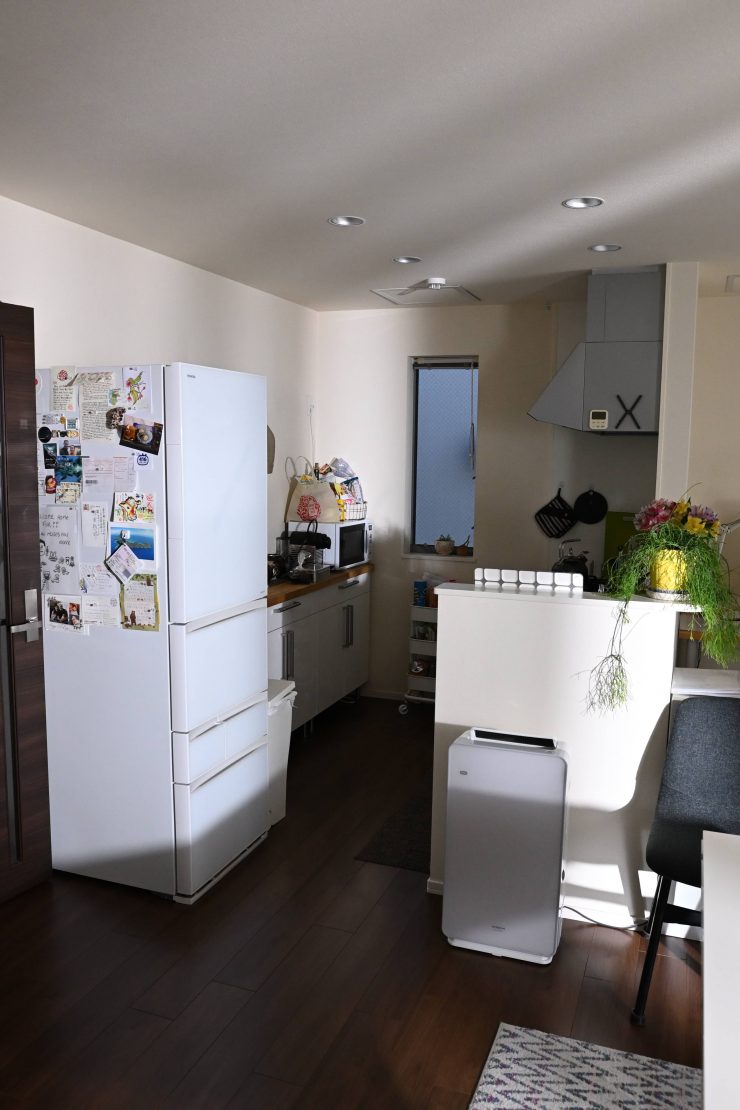

F10 Fresnel at 45° 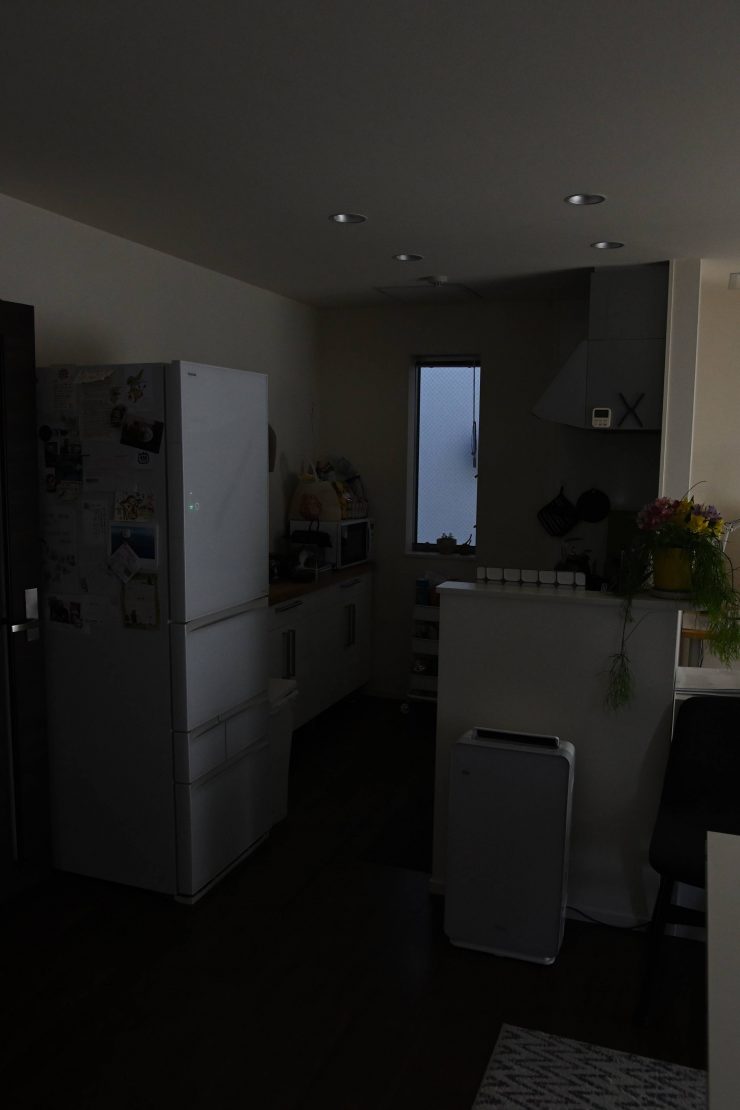
No light
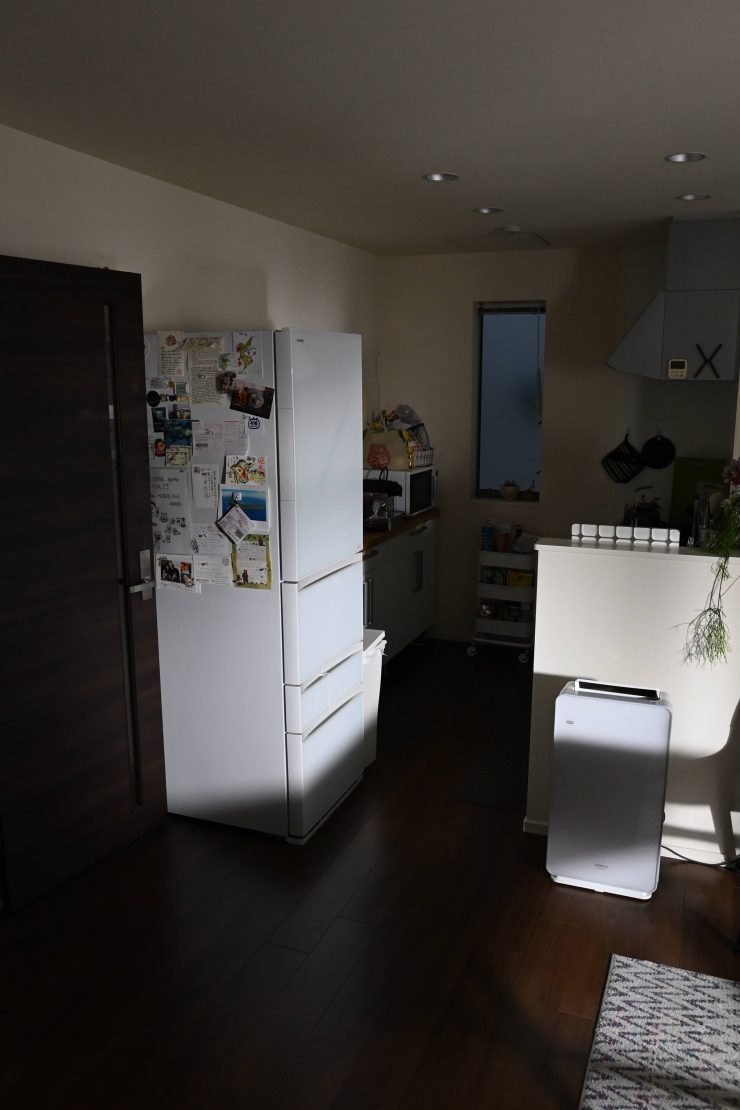

F10 Fresnel at 45° with barndoors 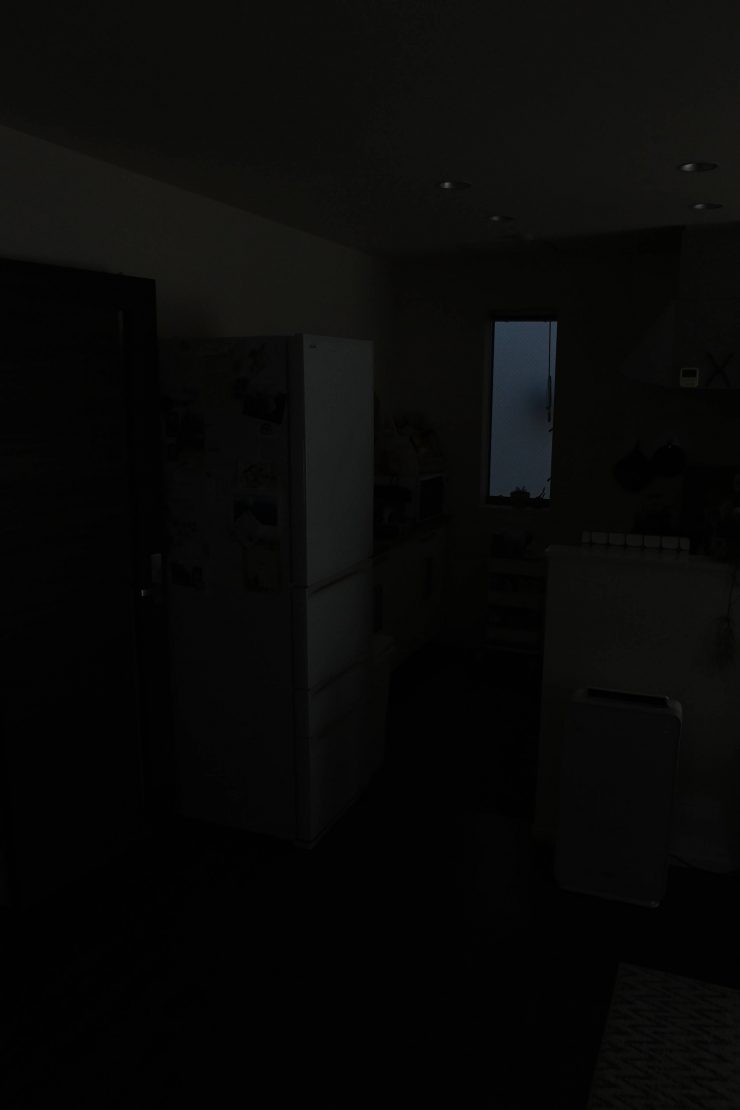
Light off
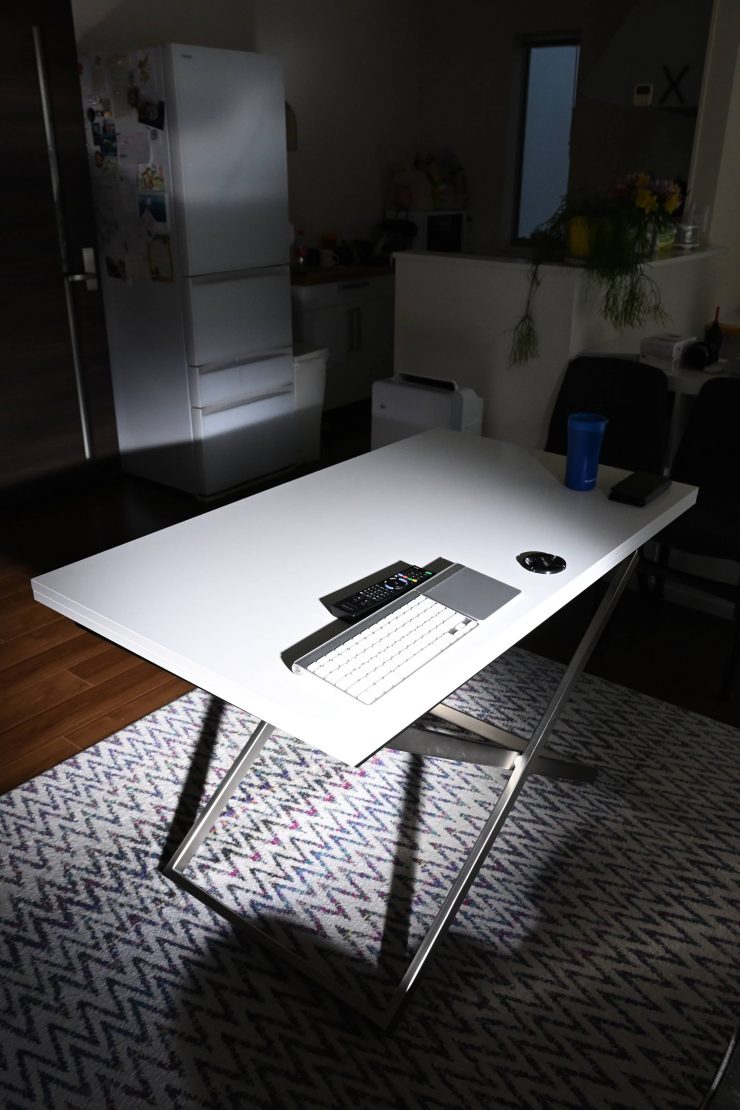

F10 Fresnel at 15° 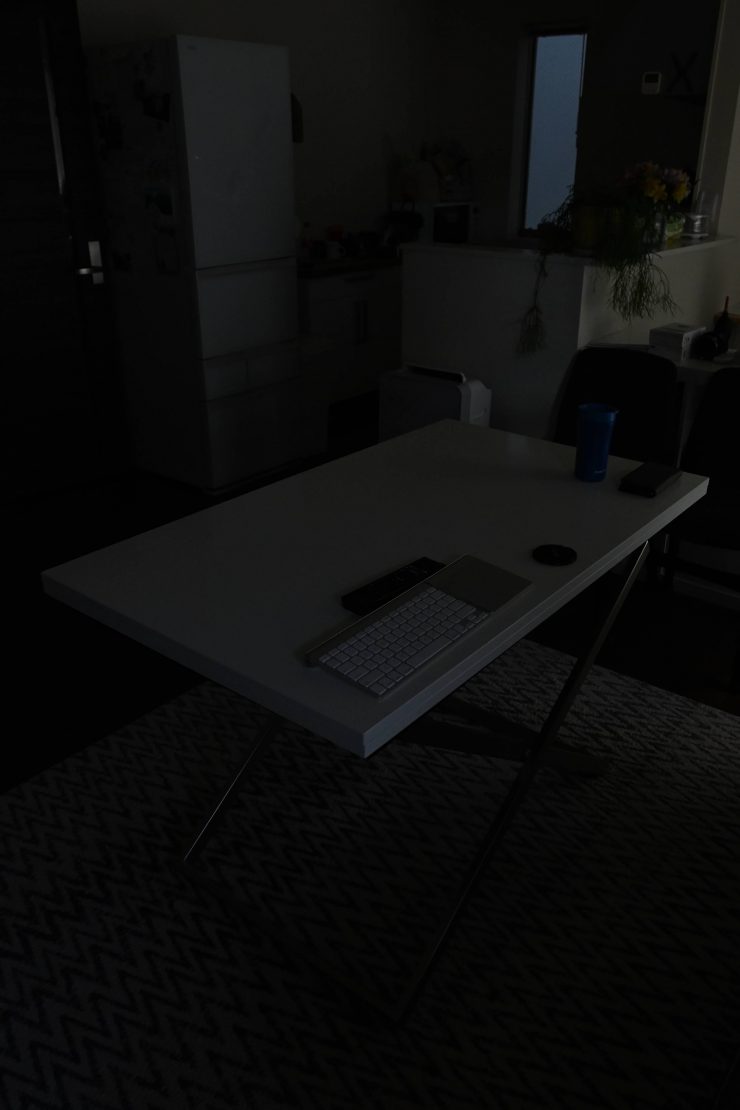
No light
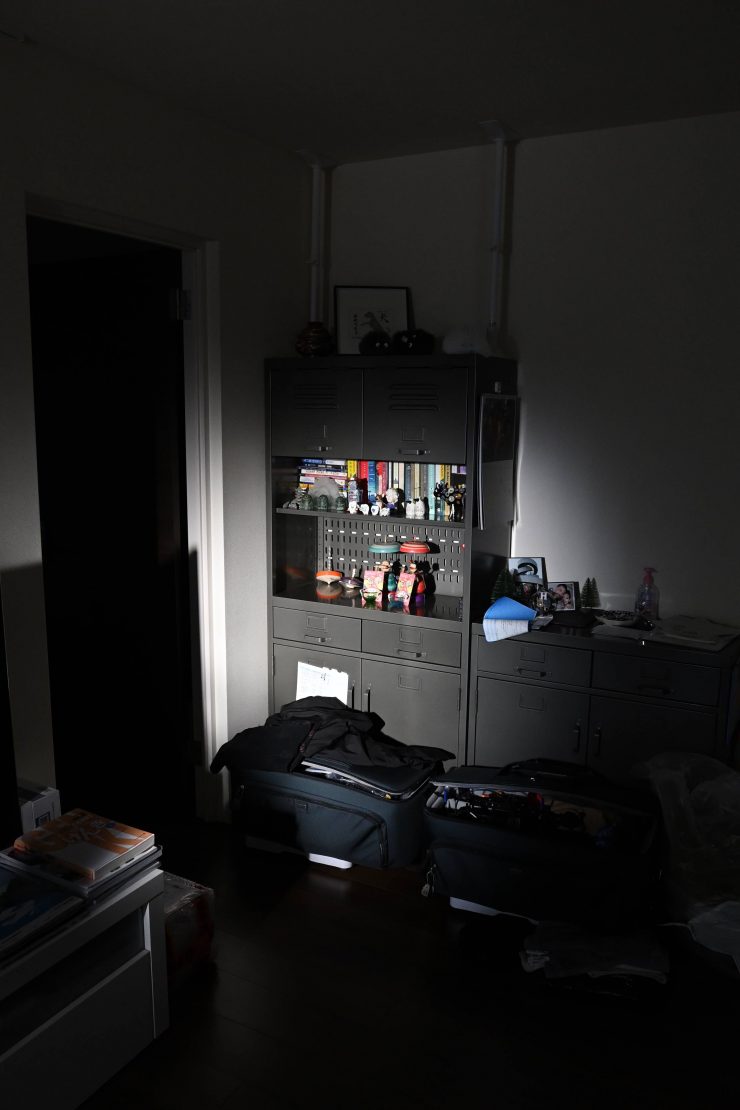

F10 Fresnel at 15° with barndoors 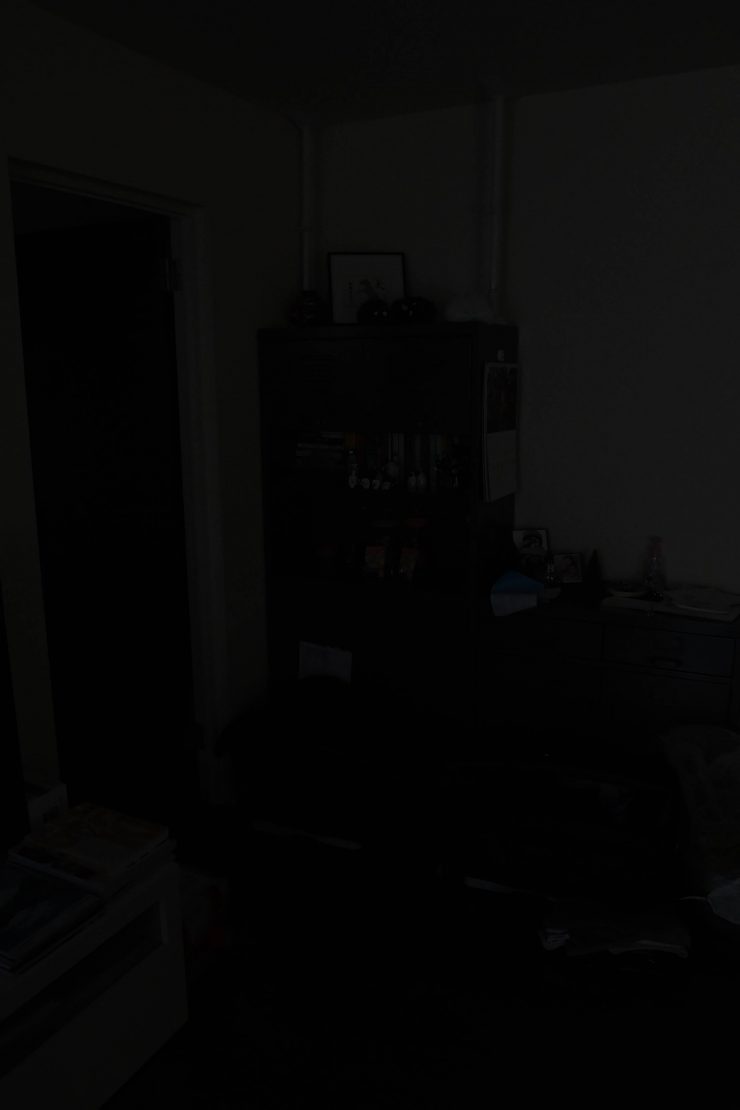
No light
Above you can see some quick examples of punching the light through a window and light curtain from outside to replicate sunlight coming in. I have taken pictures with the light on and with it off at the exact same camera settings.
Price
The F10 Fresnel Attachment for the 600d Pro retails for $219.00 USD which makes it pretty good value for money. It should be available and shipping soon.
The 10” Metal Barndoors for the F10 Fresnel will retail for $139 USD. They should also be available soon.
Yes, by the time you buy the 600d Pro, F10 Fresnel, and the barn doors you are going to be up to $2,248 USD which may sound expensive, however, for what this combination offers I think it is well priced.
Conclusion
The Aputure F10 Fresnel is well built, well thought out, and most importantly, it adds a lot of versatility if you own a 600d Pro.
The F10 is well priced for what it does and if you need a ton of output for your 600d Pro then it is a nice addition. For a lot of users, this combination will probably be overkill and something like a 300d would be a better option.
If you are a solo operator or travelling a lot, the 600d Pro, F10 and the F10 Barndoors may or may not be suitable for you. While the 600d Pro does come in a case, you would then have to additionally carry around the F10 and the F10 Barndoors which could be a potential red flag for some potential users.
I was impressed with the F10 and 600d Pro combination. It allows you to achieve similar results to a lot more power-hungry and larger HMIs for a lot less money.
It has been a while since I reviewed an Aputure product and they have certainly improved since the early Light Storm fixtures. At least, in my opinion, the 600d Pro and the F10 Fresnel are the first Aputure products that I would consider to be suitable for rental houses.
Once you step up in class, usually three things tend to happen. The build quality gets better, which means the size and weight, as well as the price, have to increase. The 600d Pro, F10 Fresnel, and F10 barn doors show me that Aputure has started to take a different direction.
If you want to go more mainstream and get your products on larger productions and into more rental houses, you need to make them a lot more robust. As I just mentioned, that is sometimes going to come at the cost of weight and size. I don’t personally mind that the 600d Pro and the F10 and the F10 Barndoors are large and heavy because Aputure has made them a lot more robust than earlier products.
I highly recommend the F10 Fresnel. It is the first affordable COB LED Fresnel attachment that I actually think works well enough to be compared against HMI fixtures.
Like what we do and want to support Newsshooter? Consider becoming a Patreon supporter and help us to continue being the best source of news and reviews for professional tools for the independent filmmaker.

